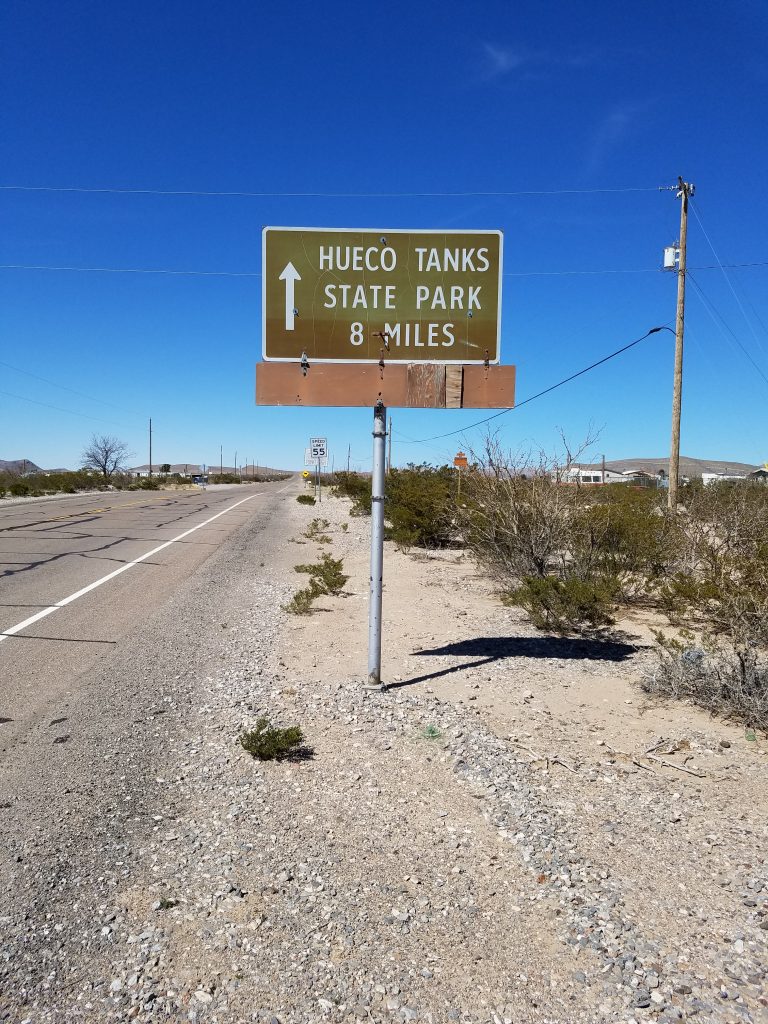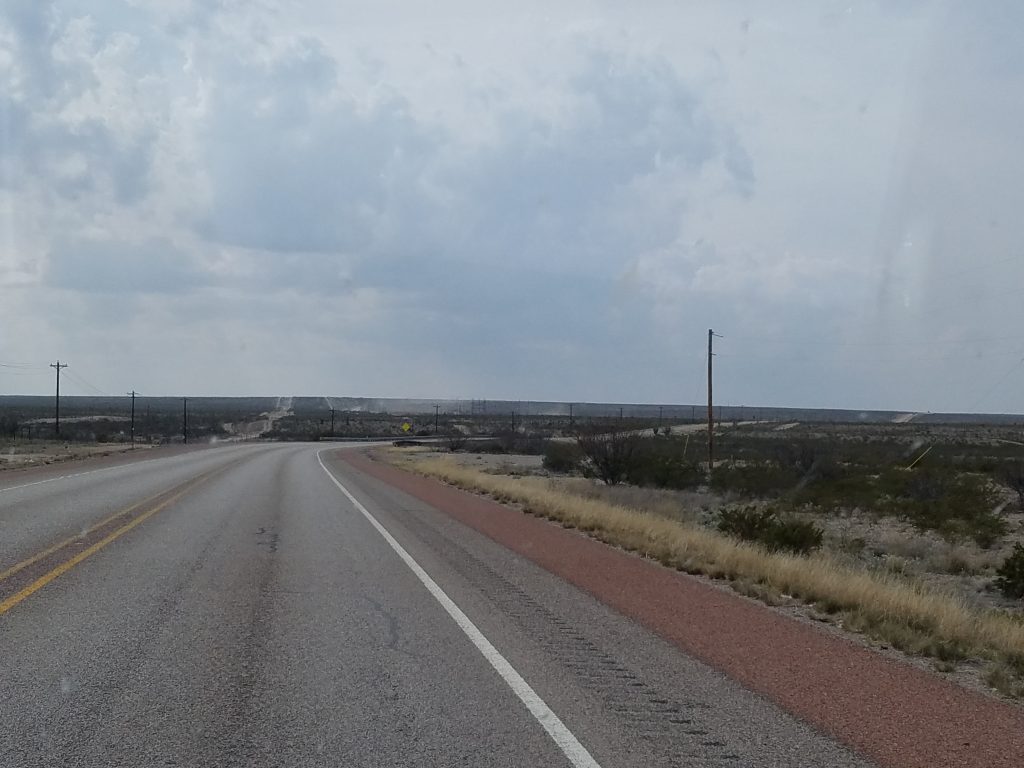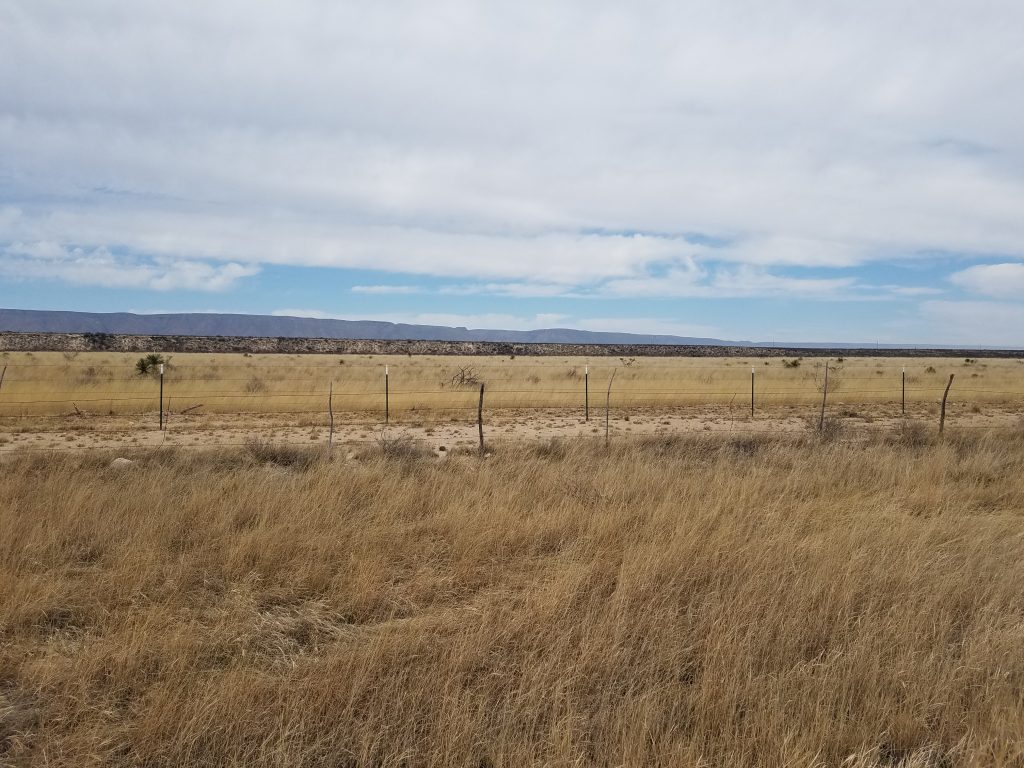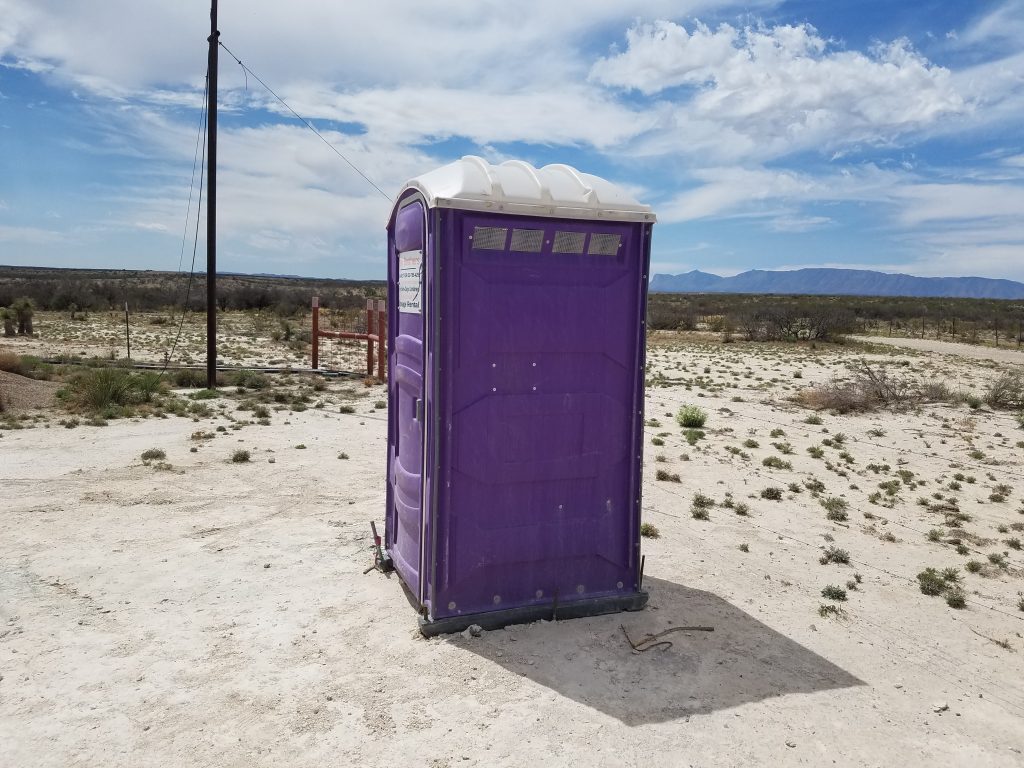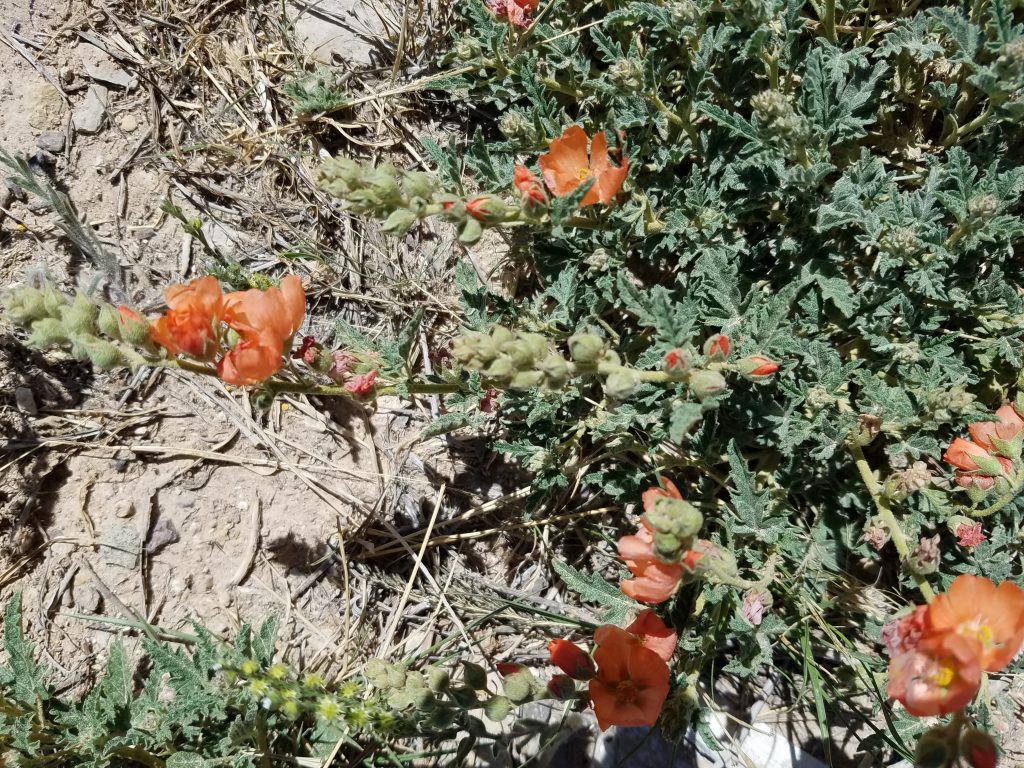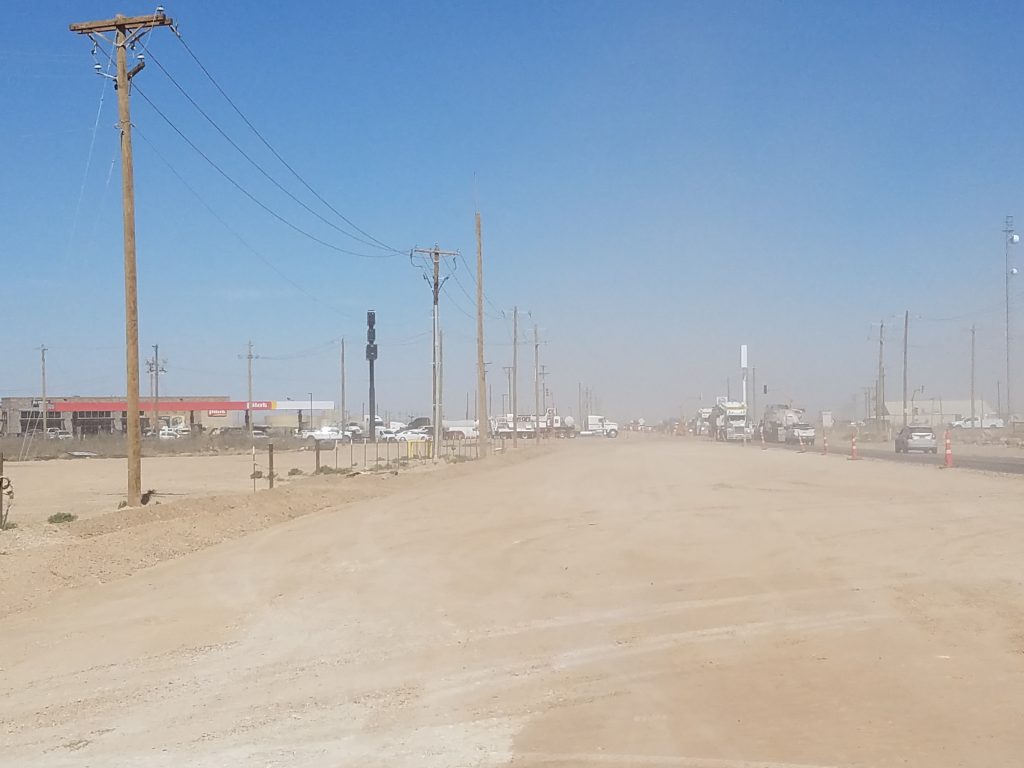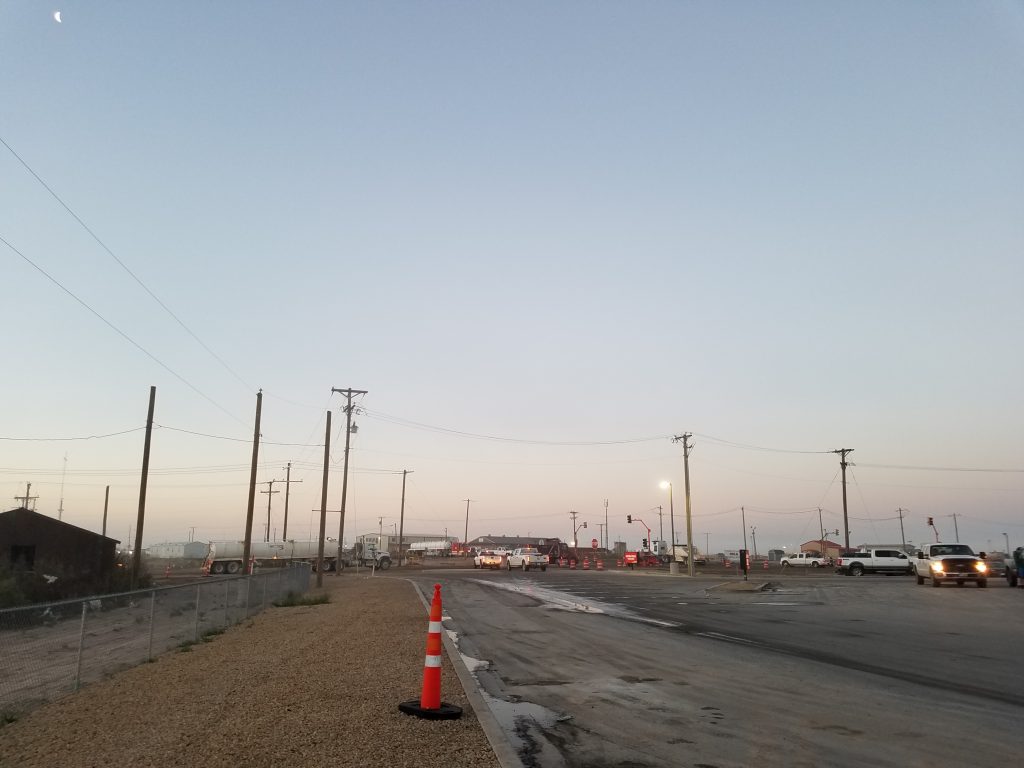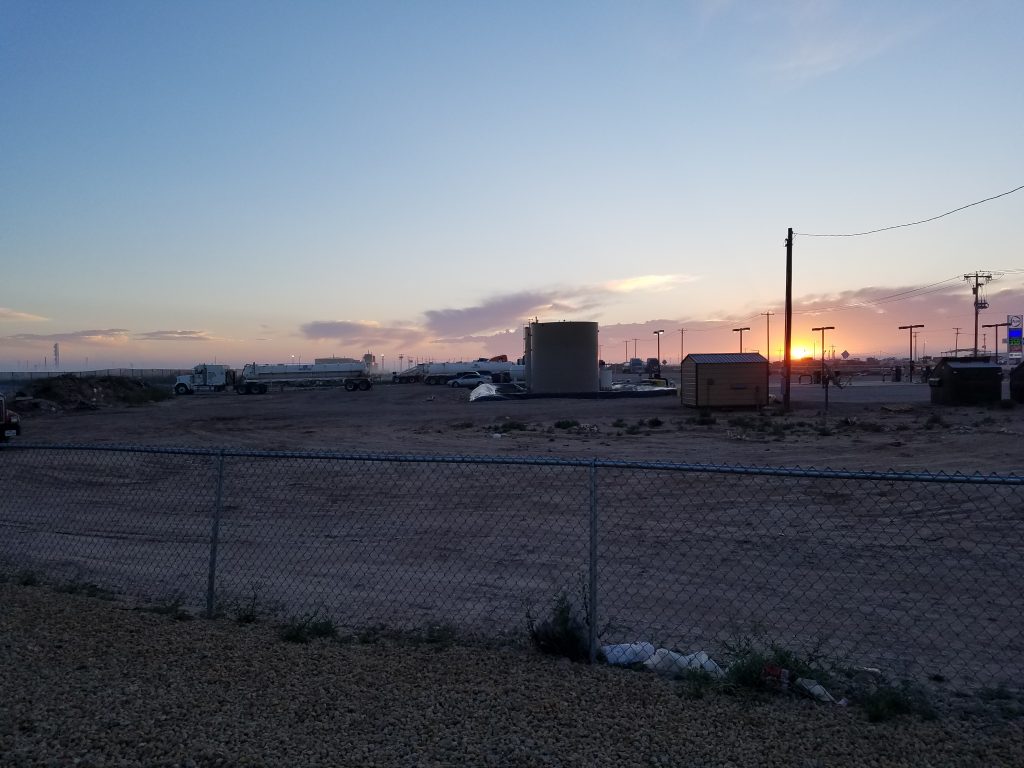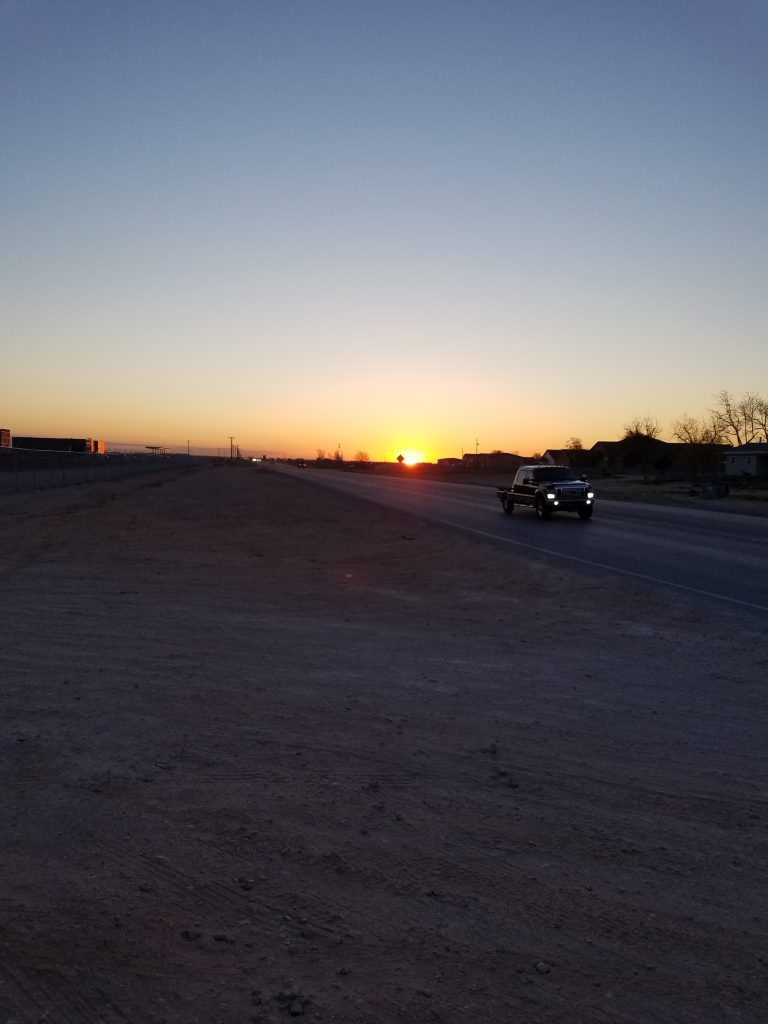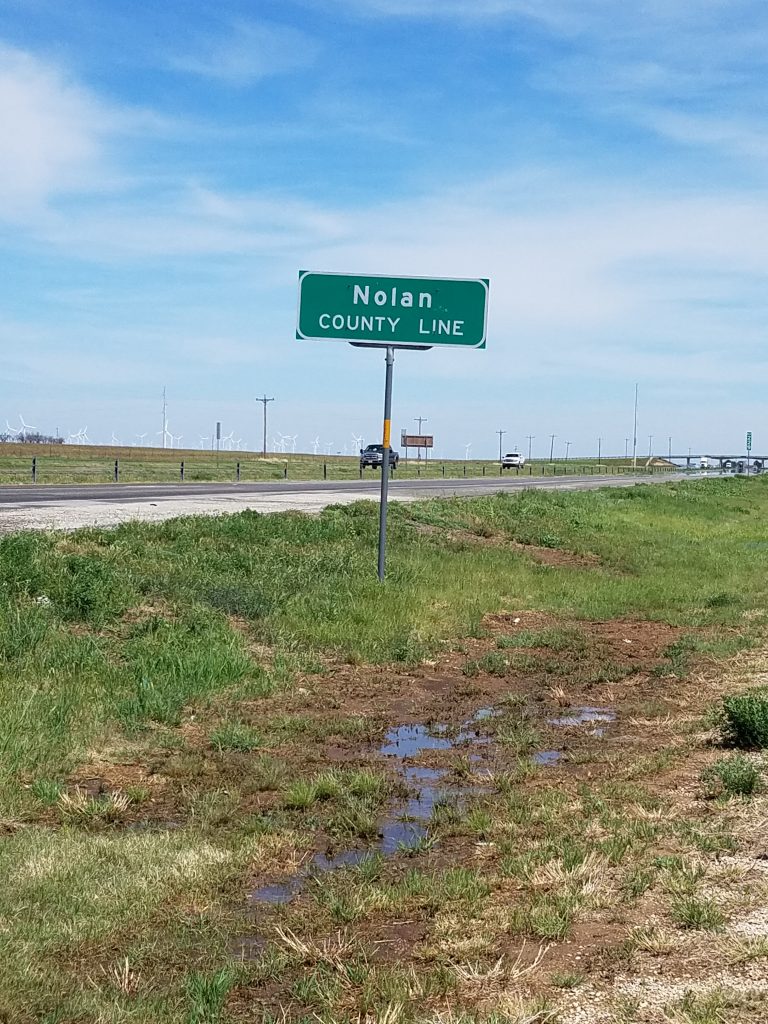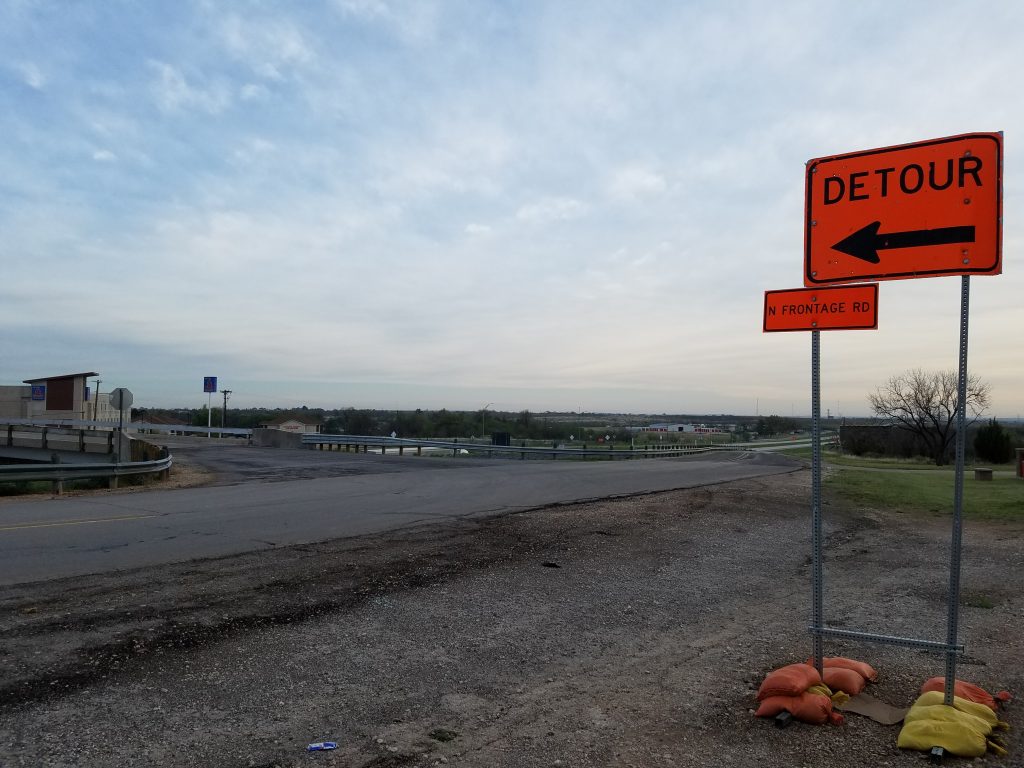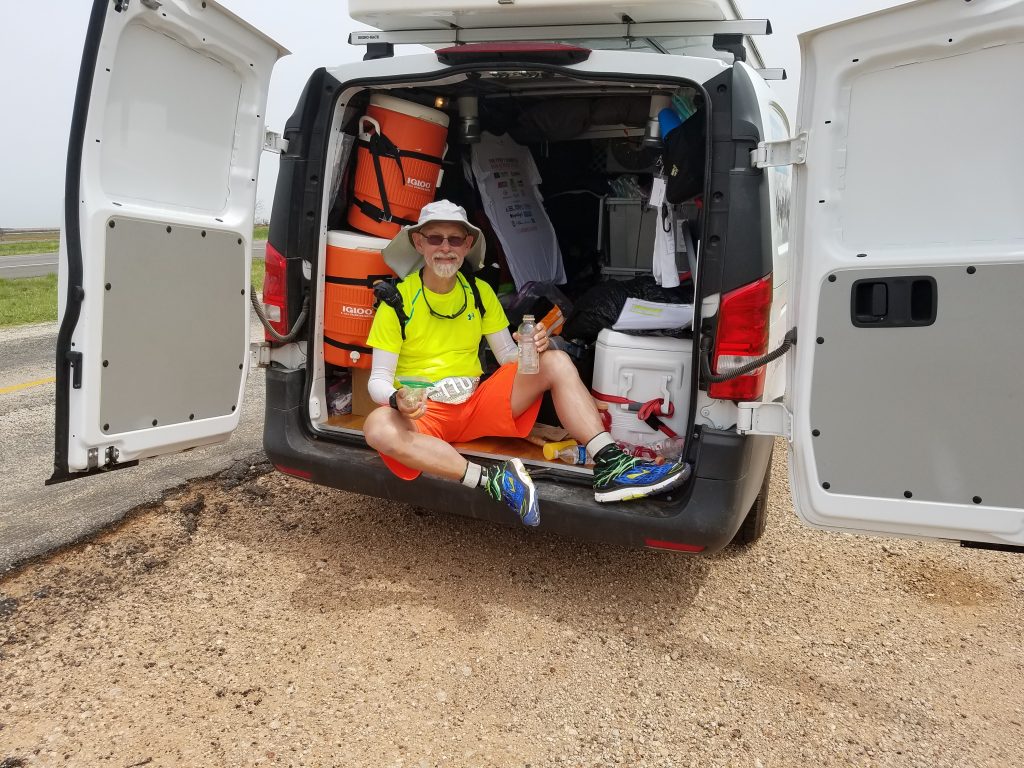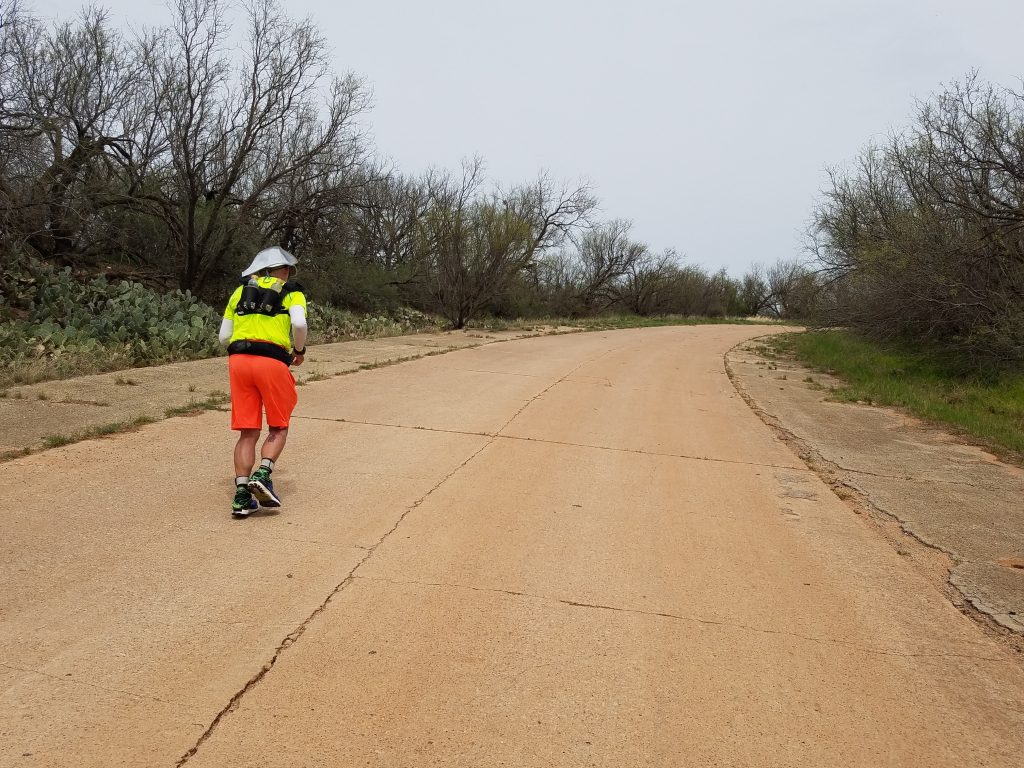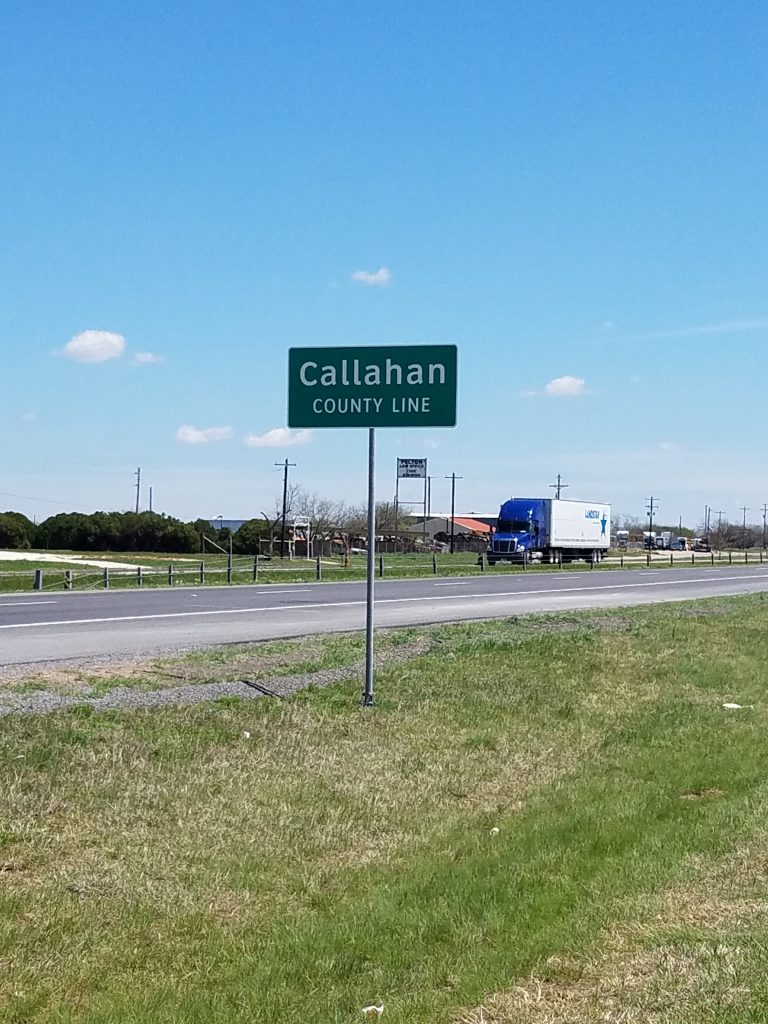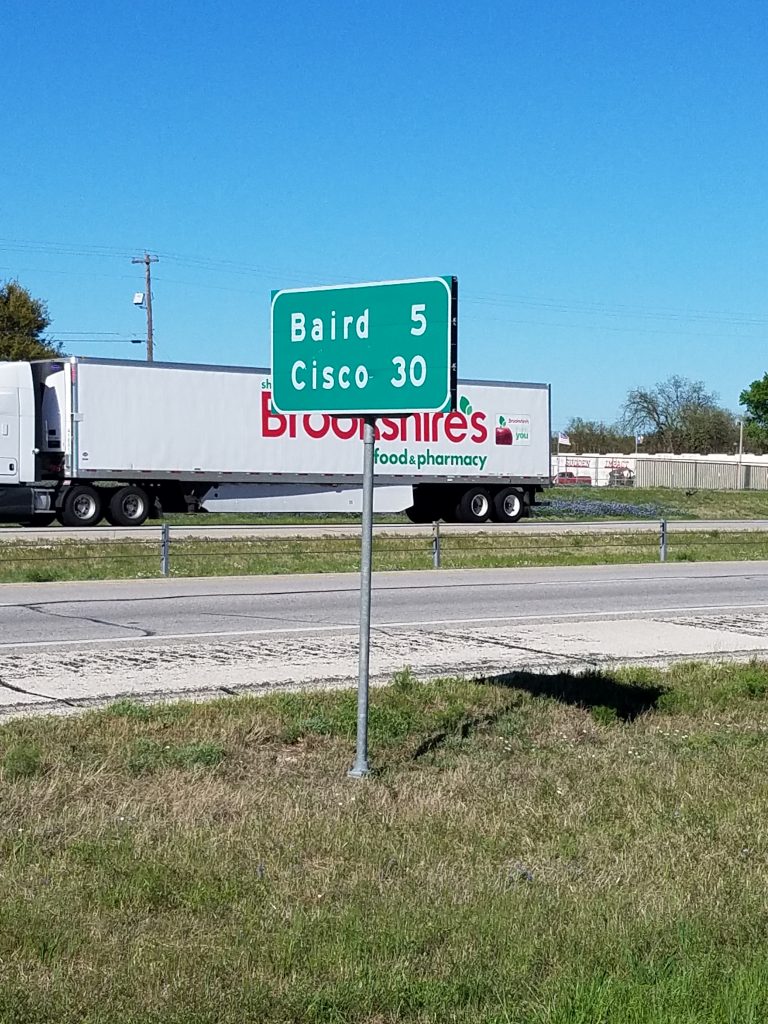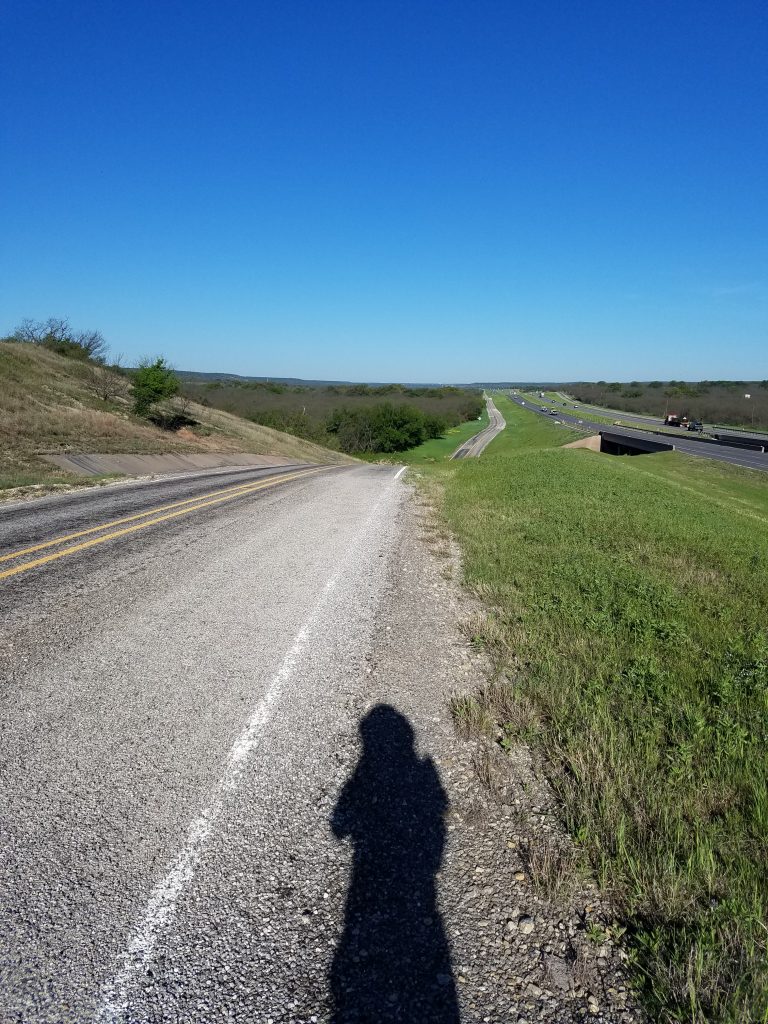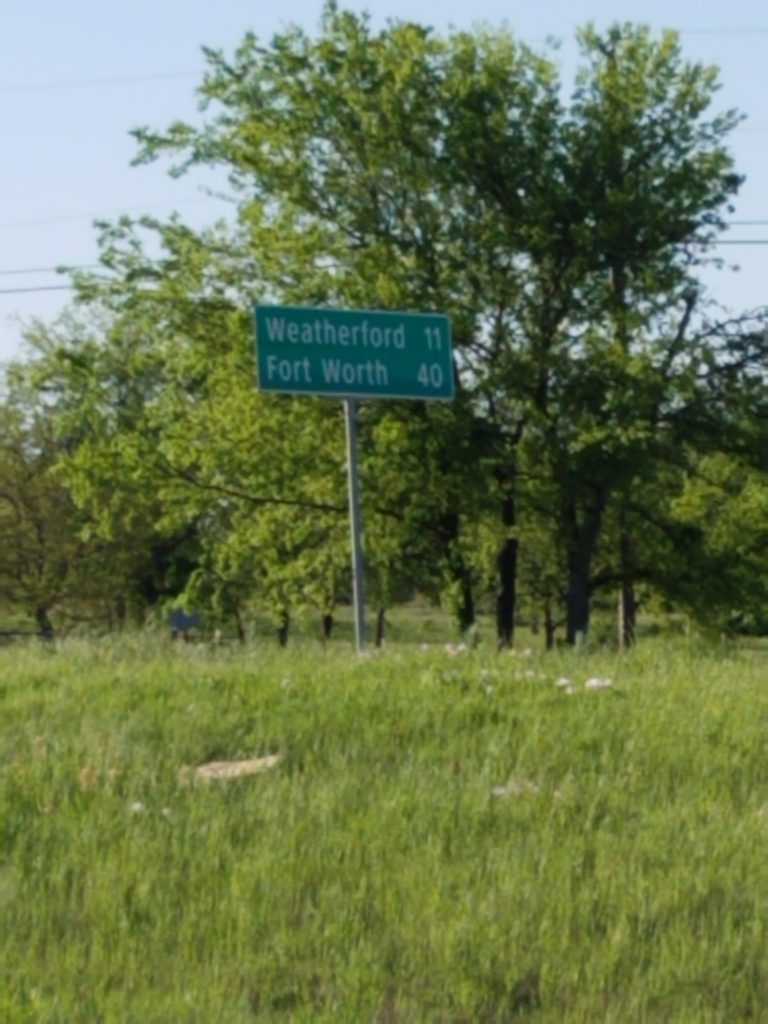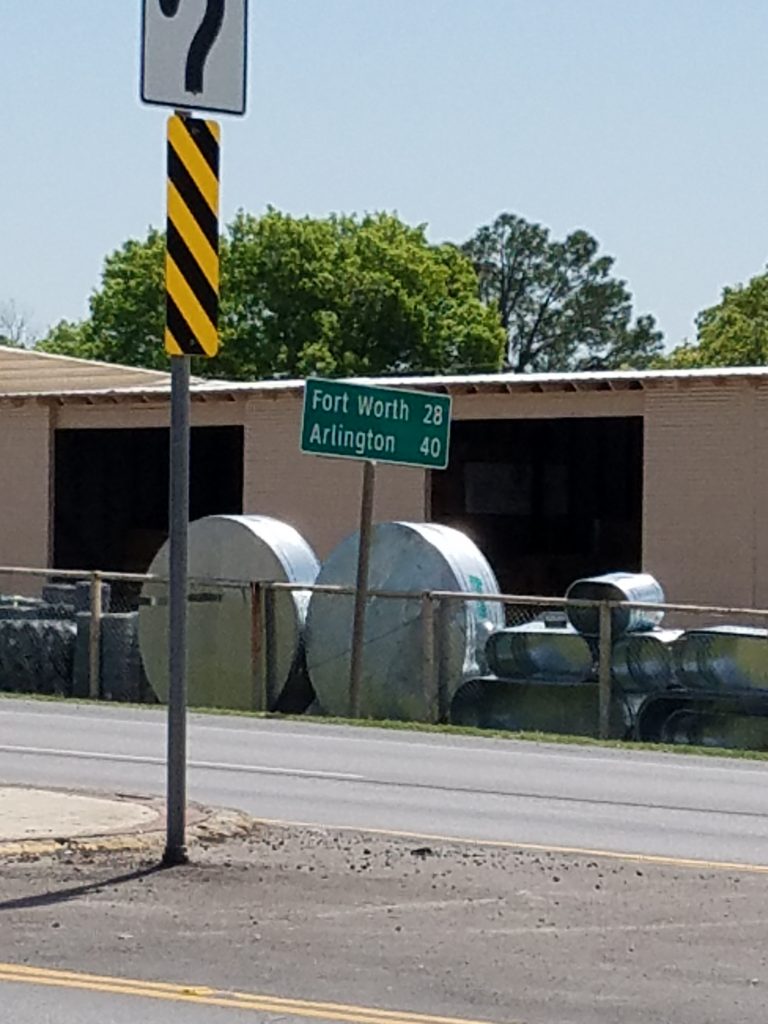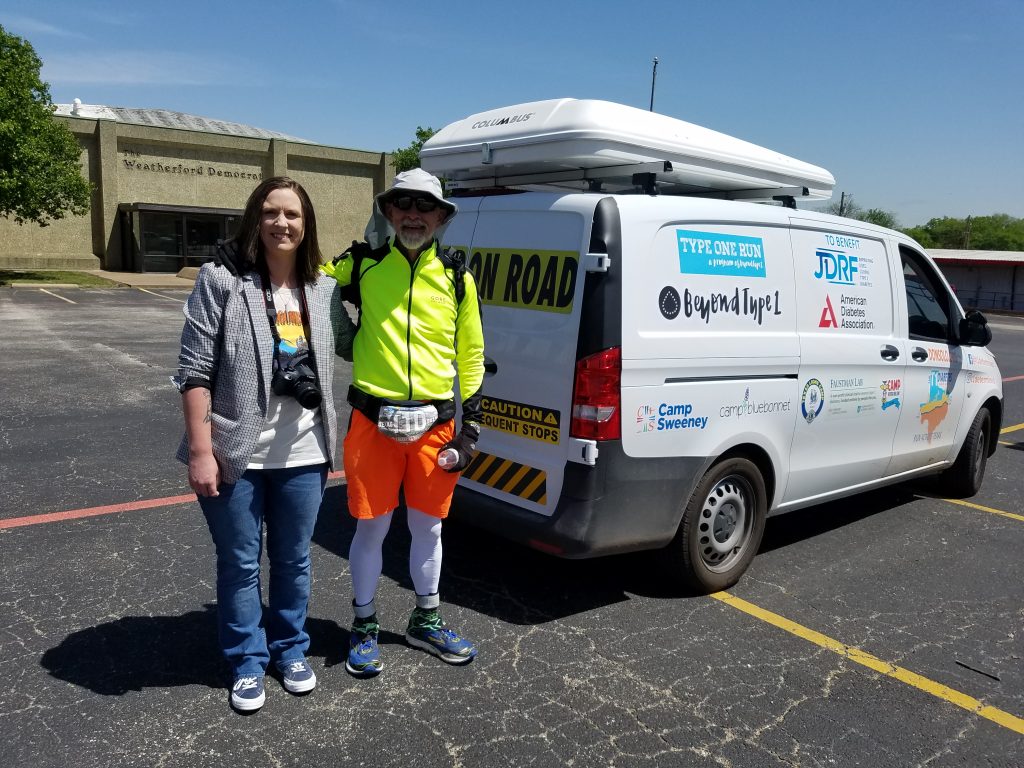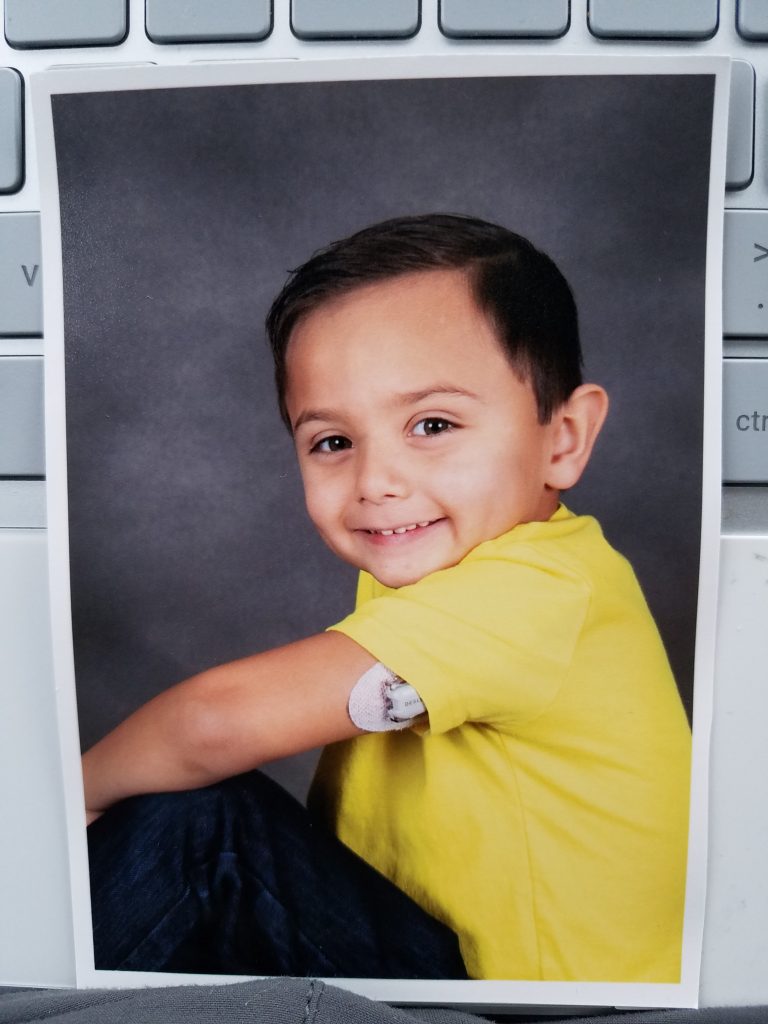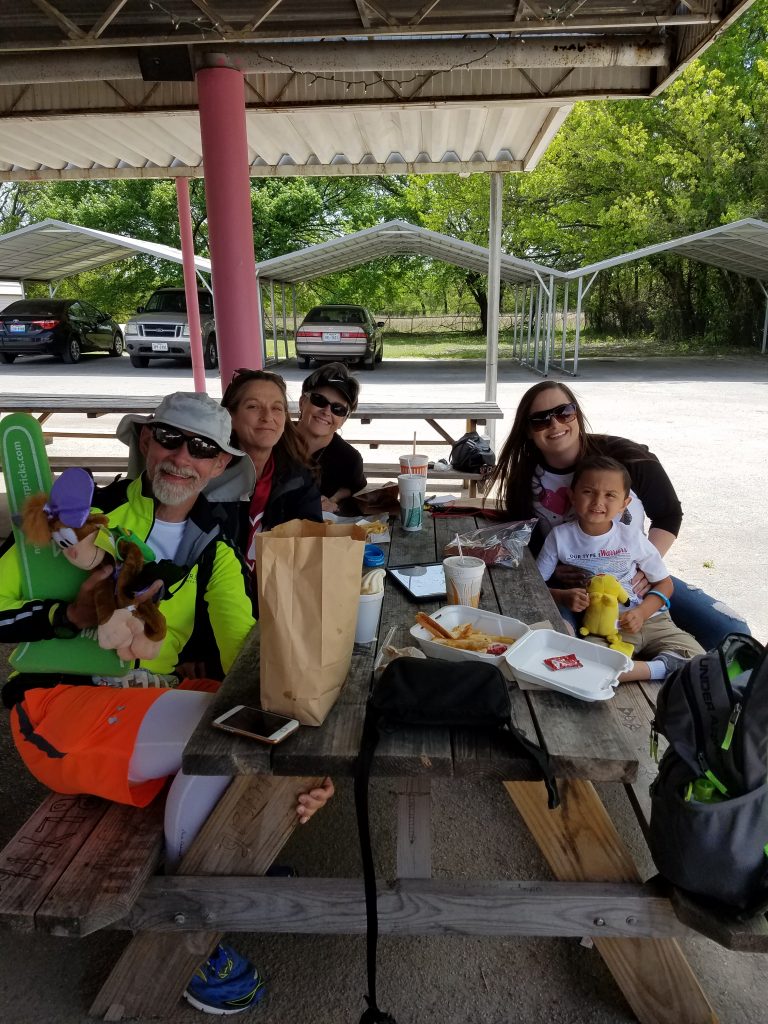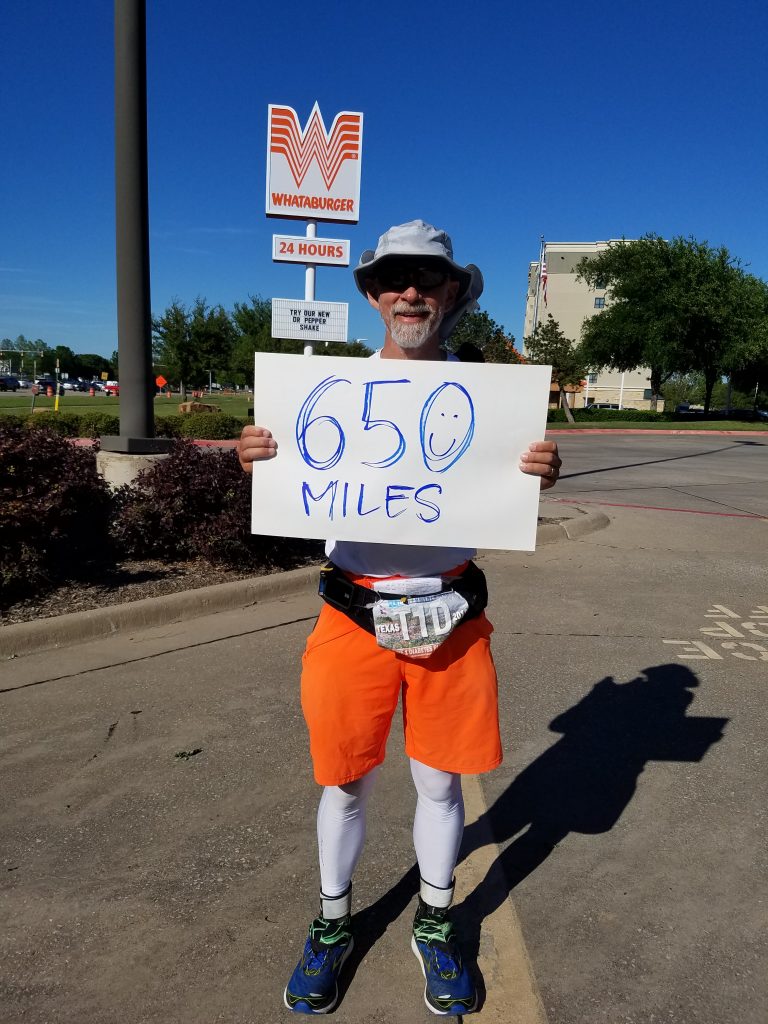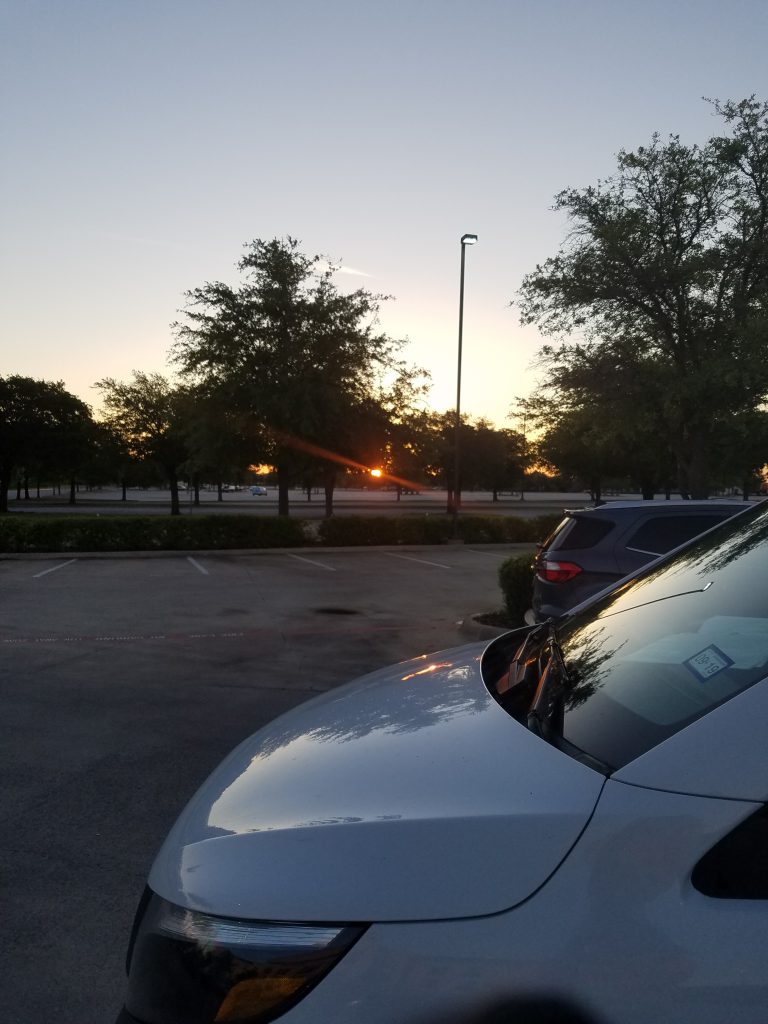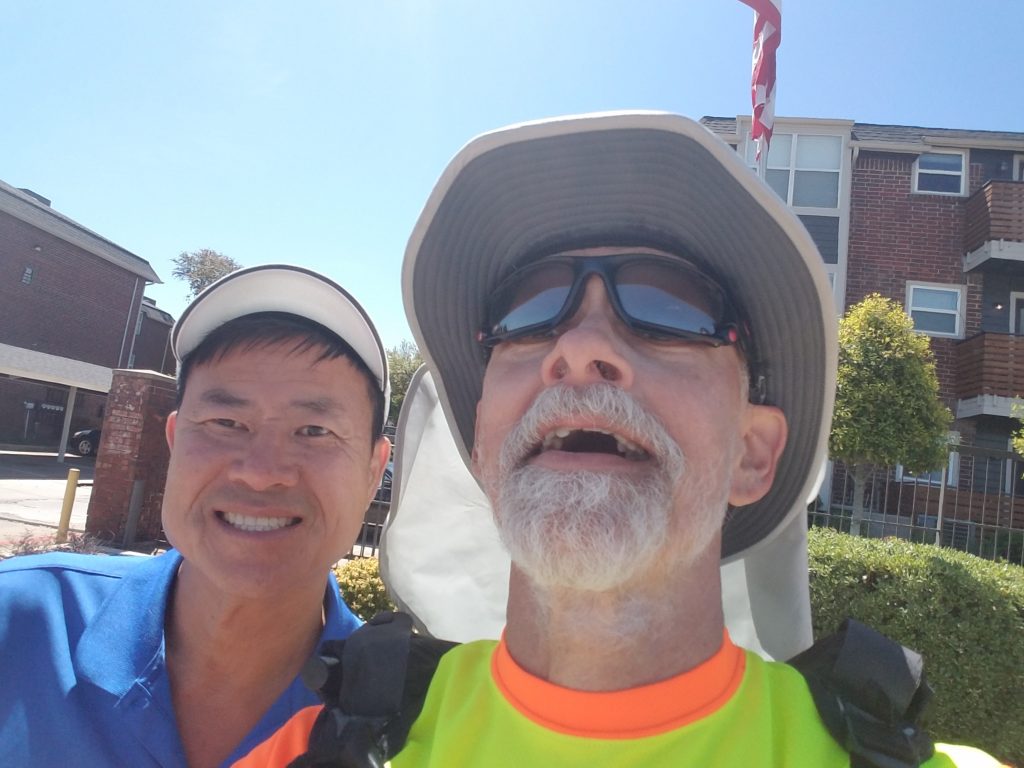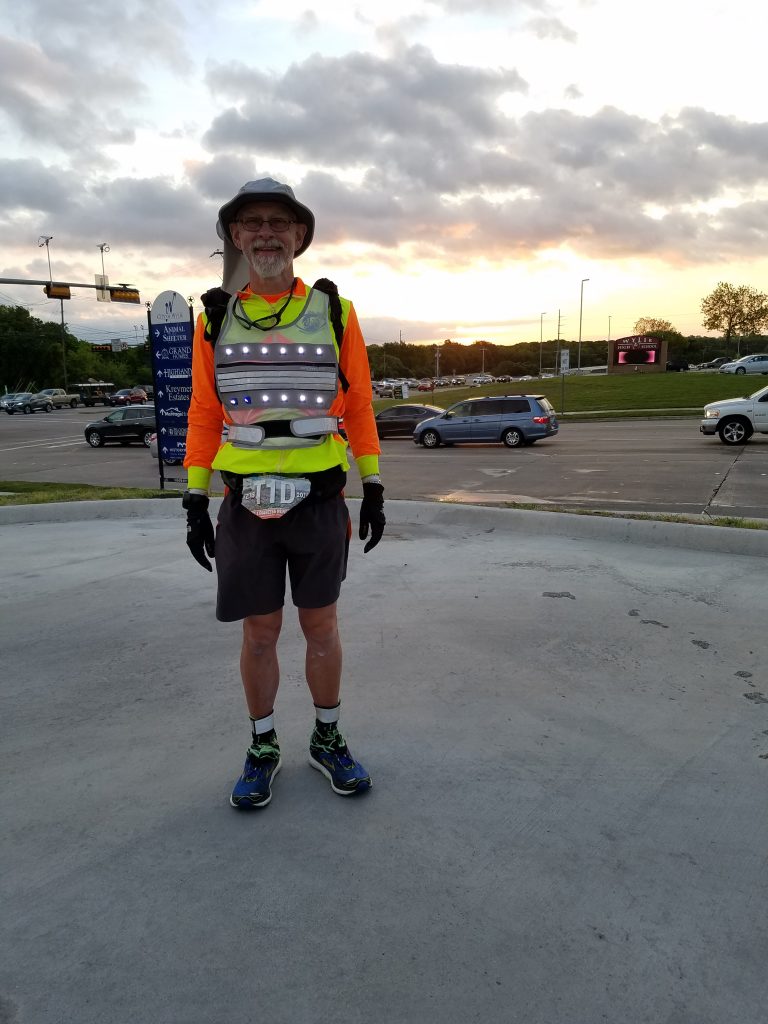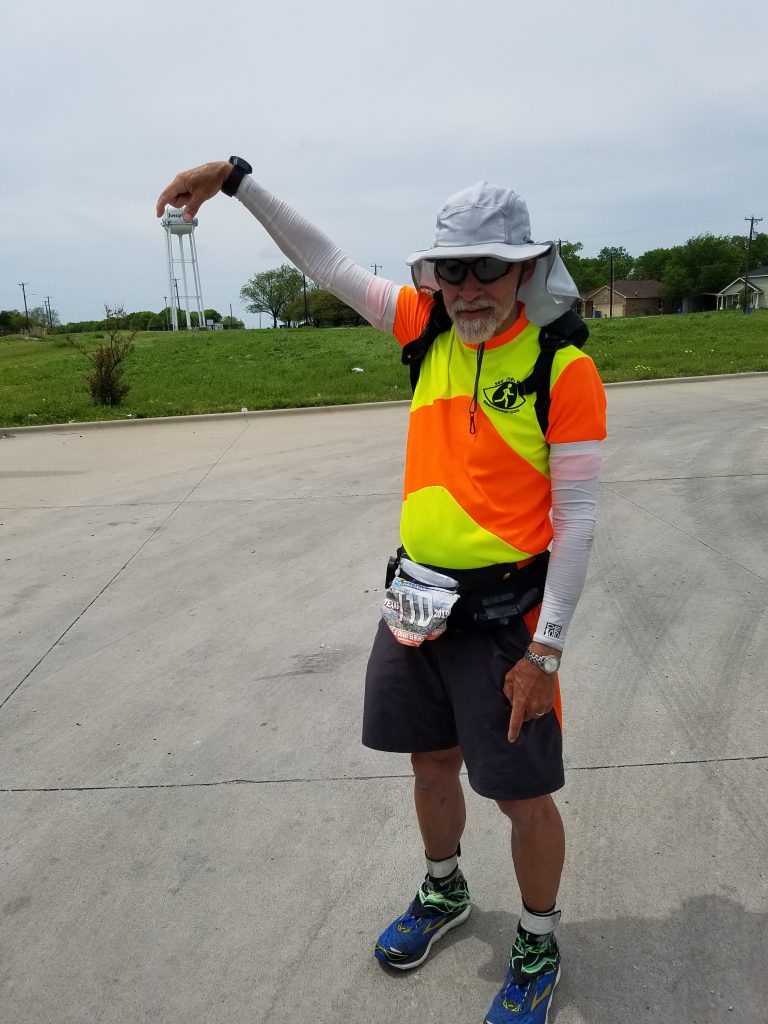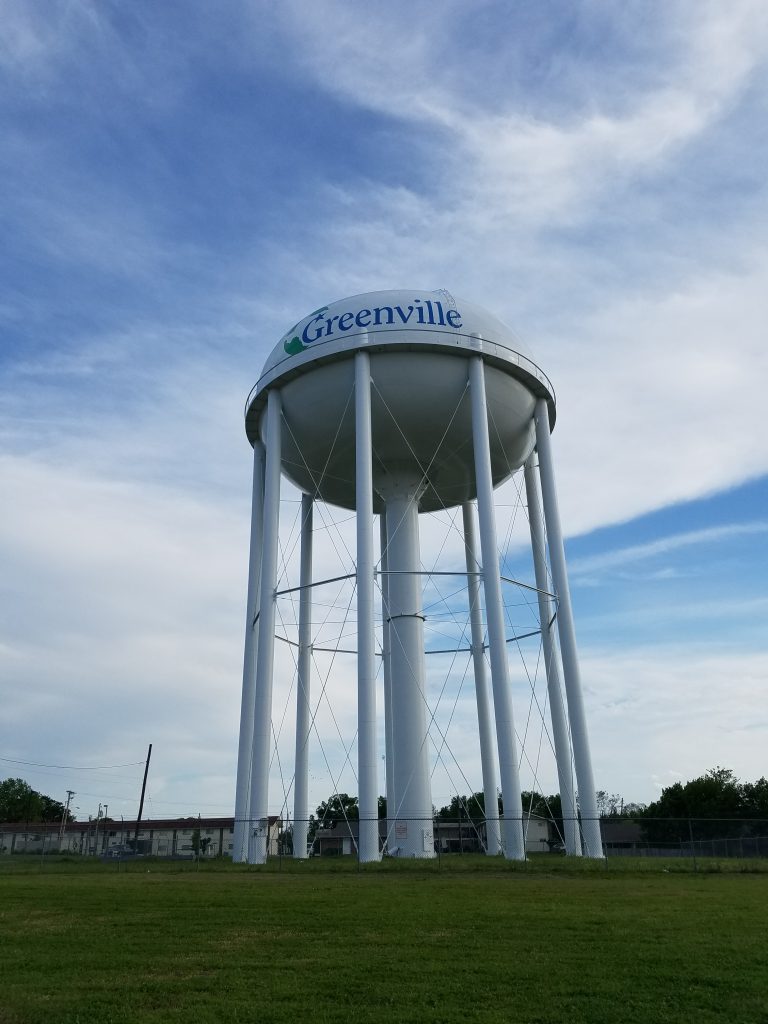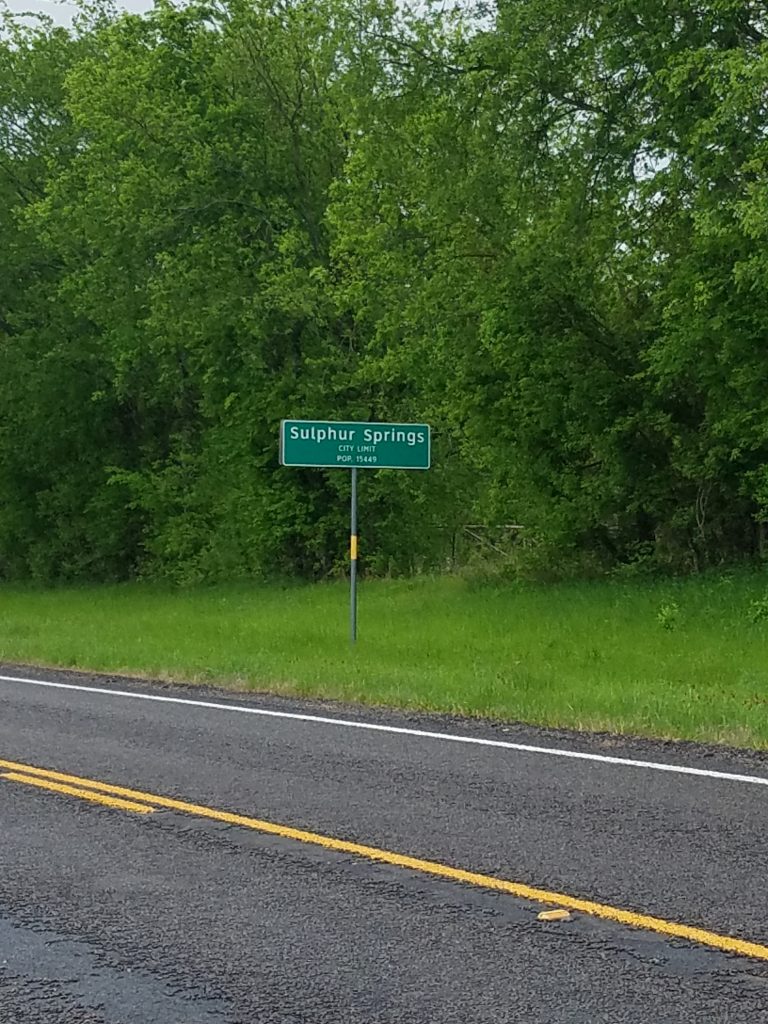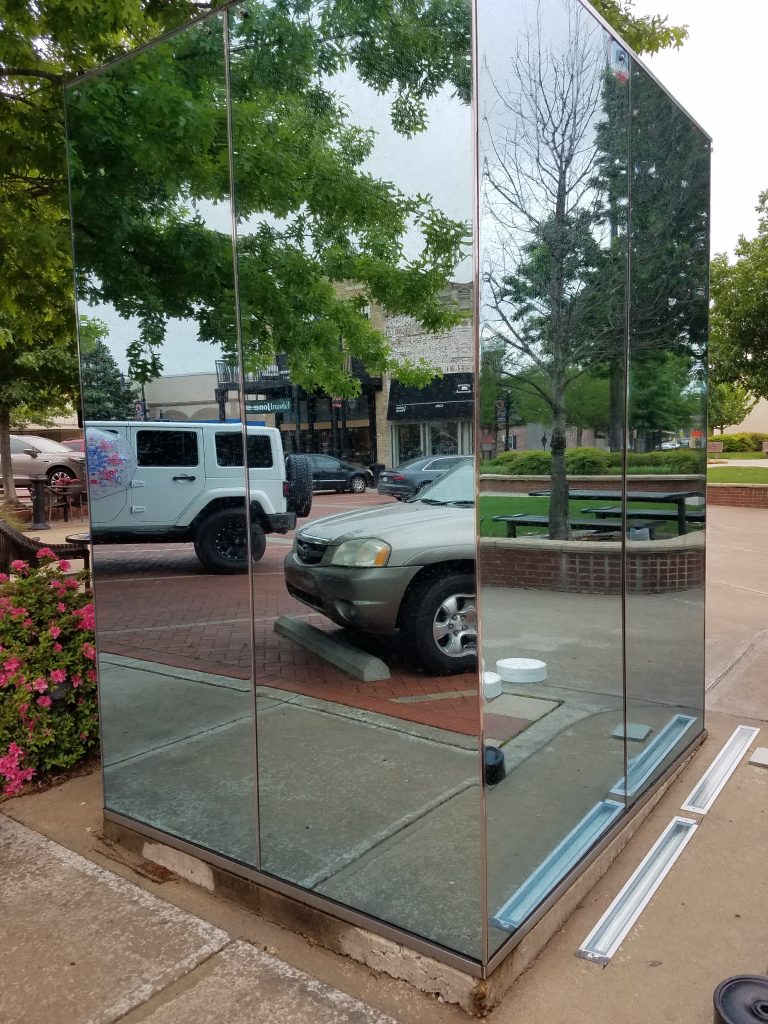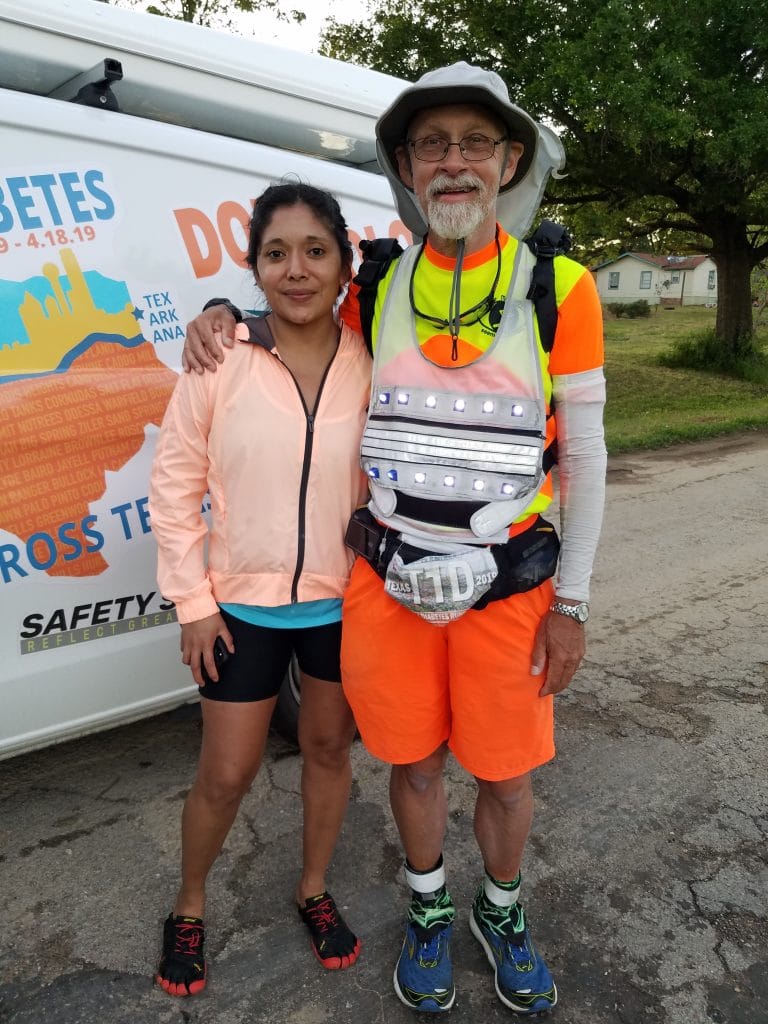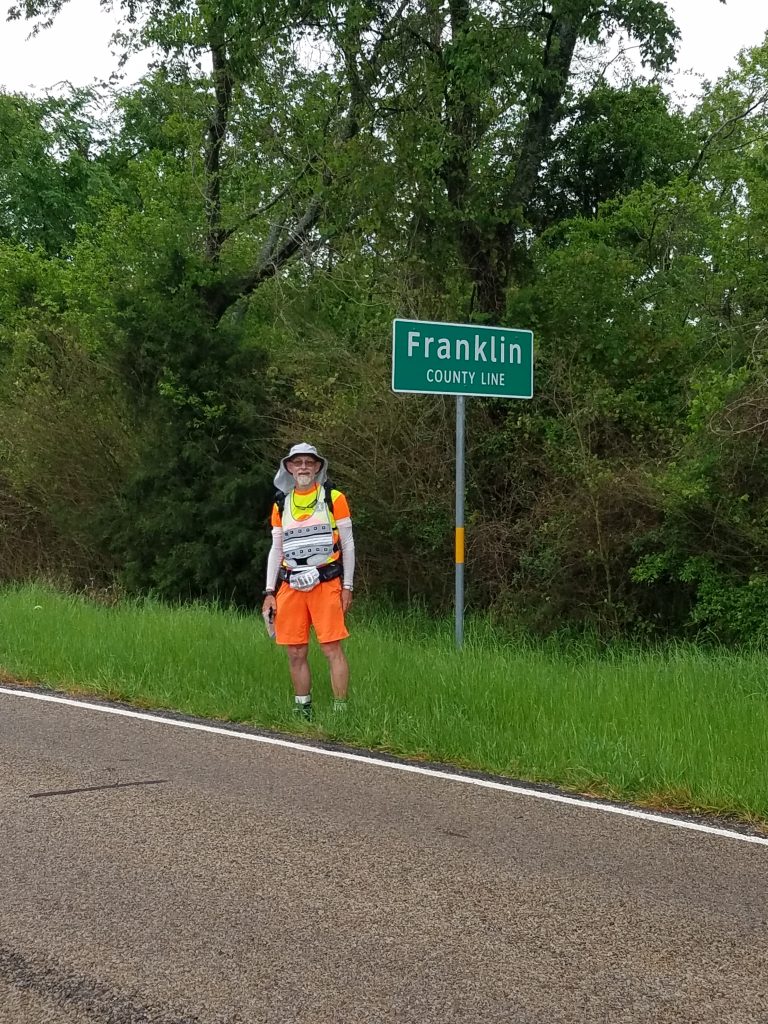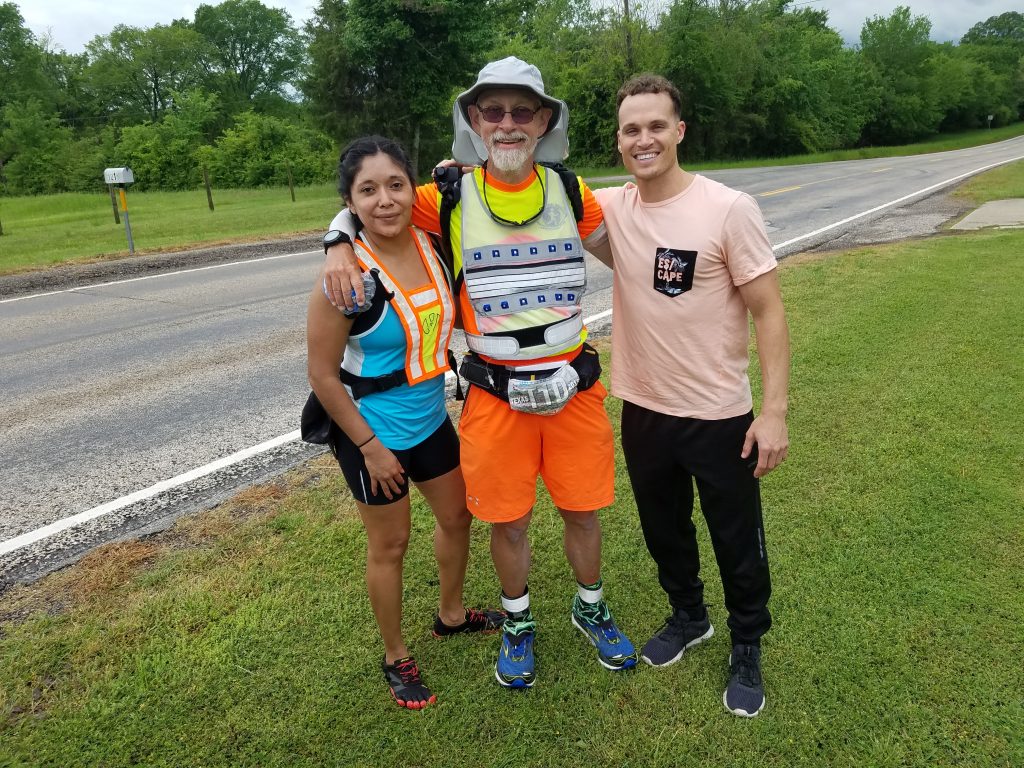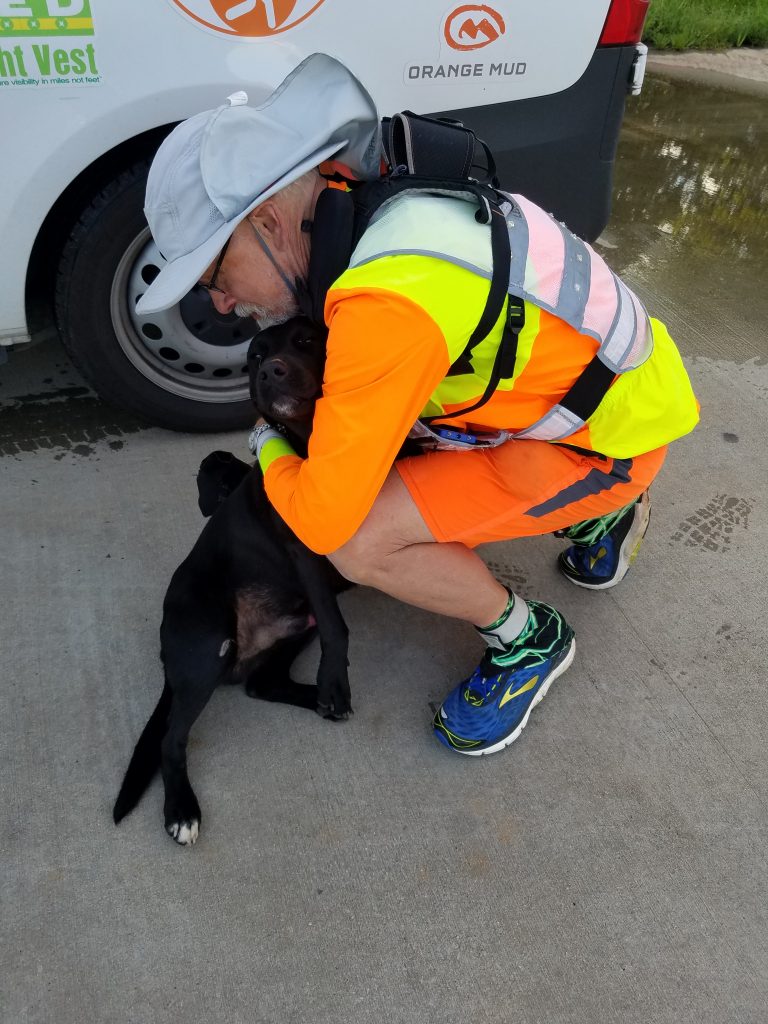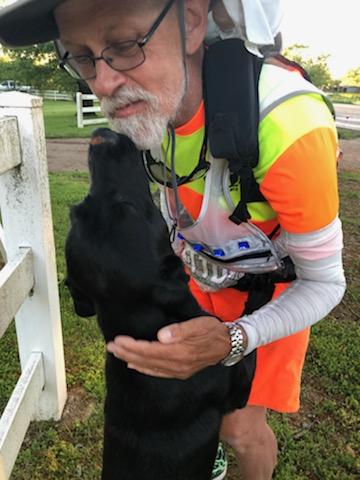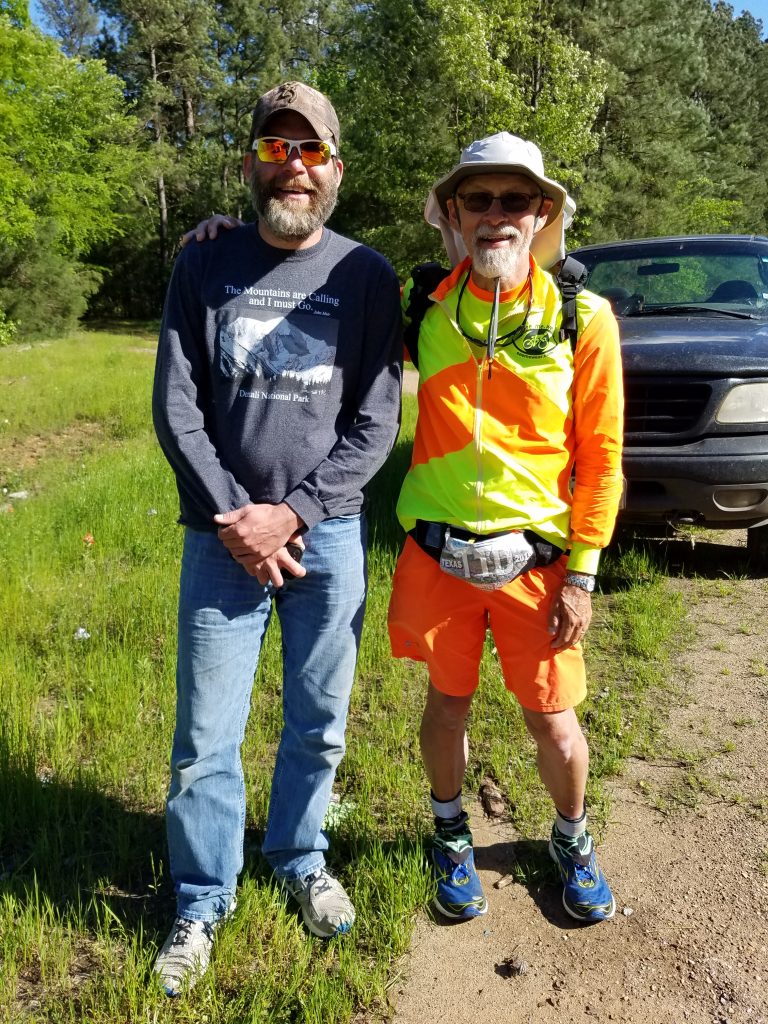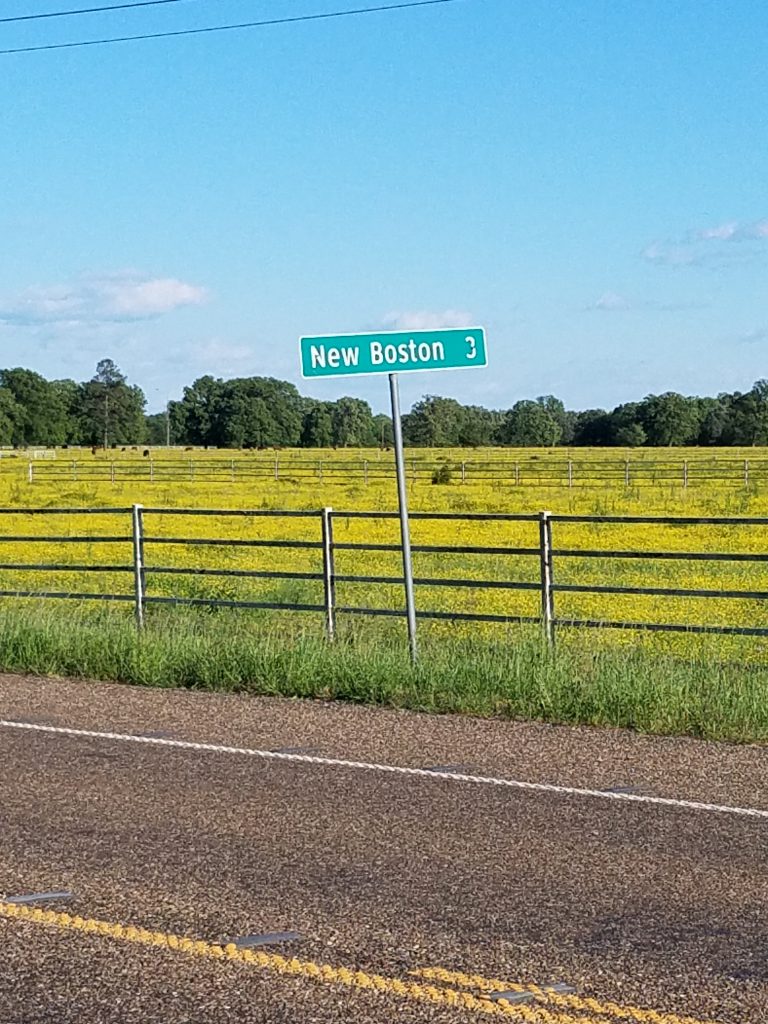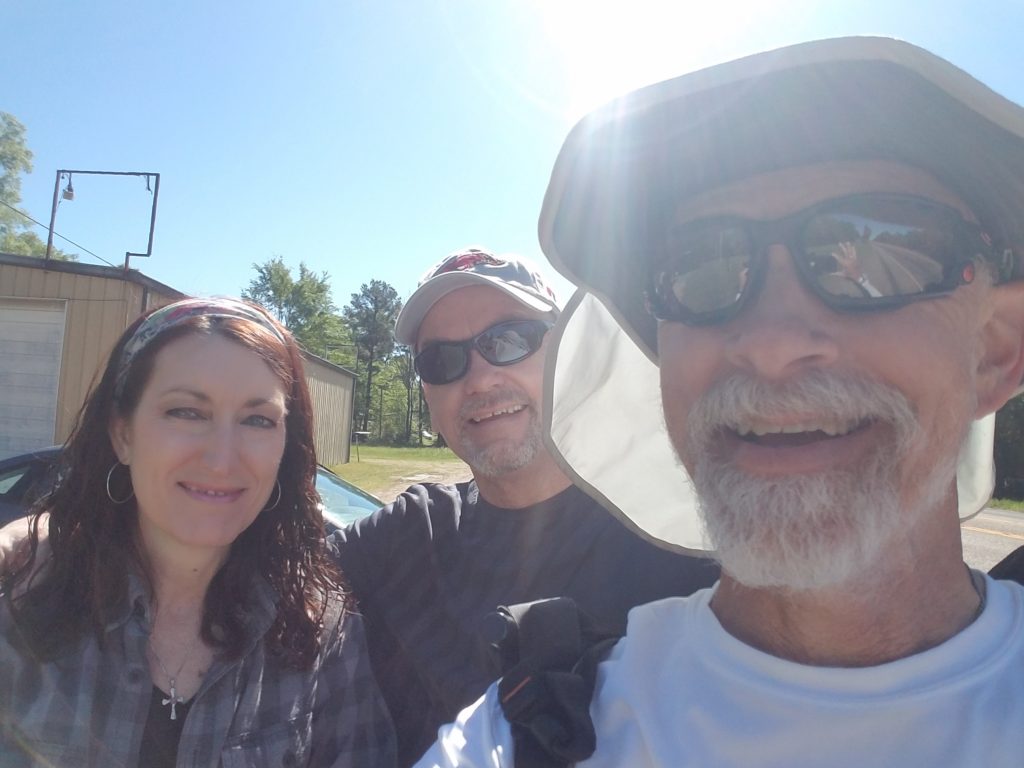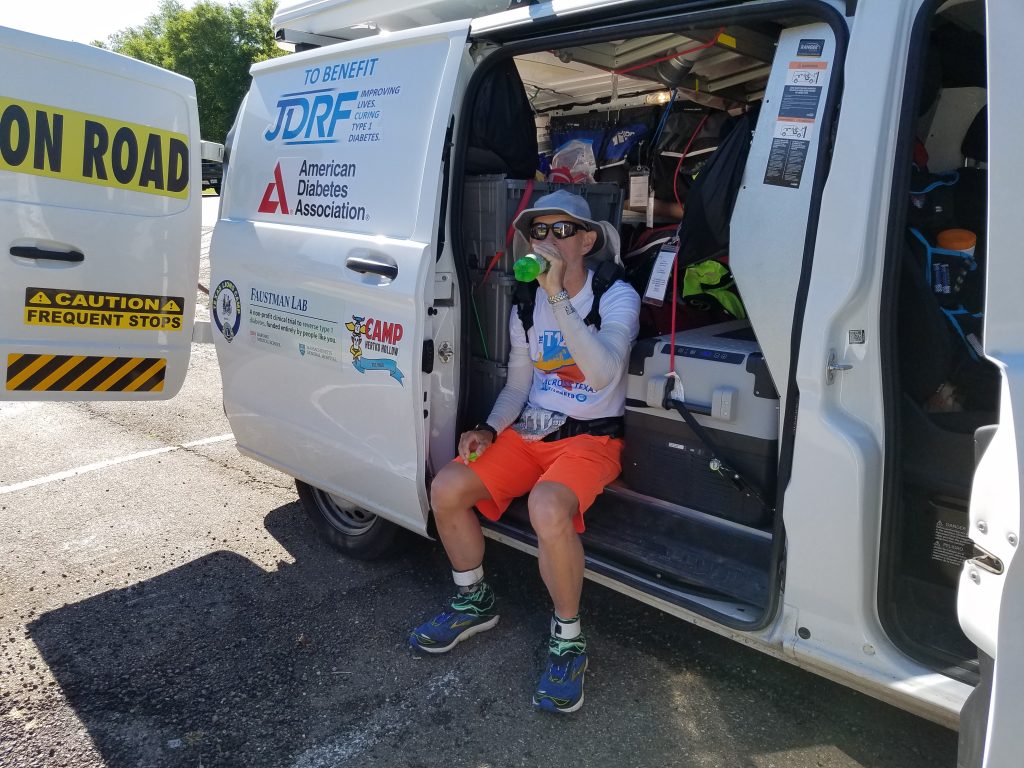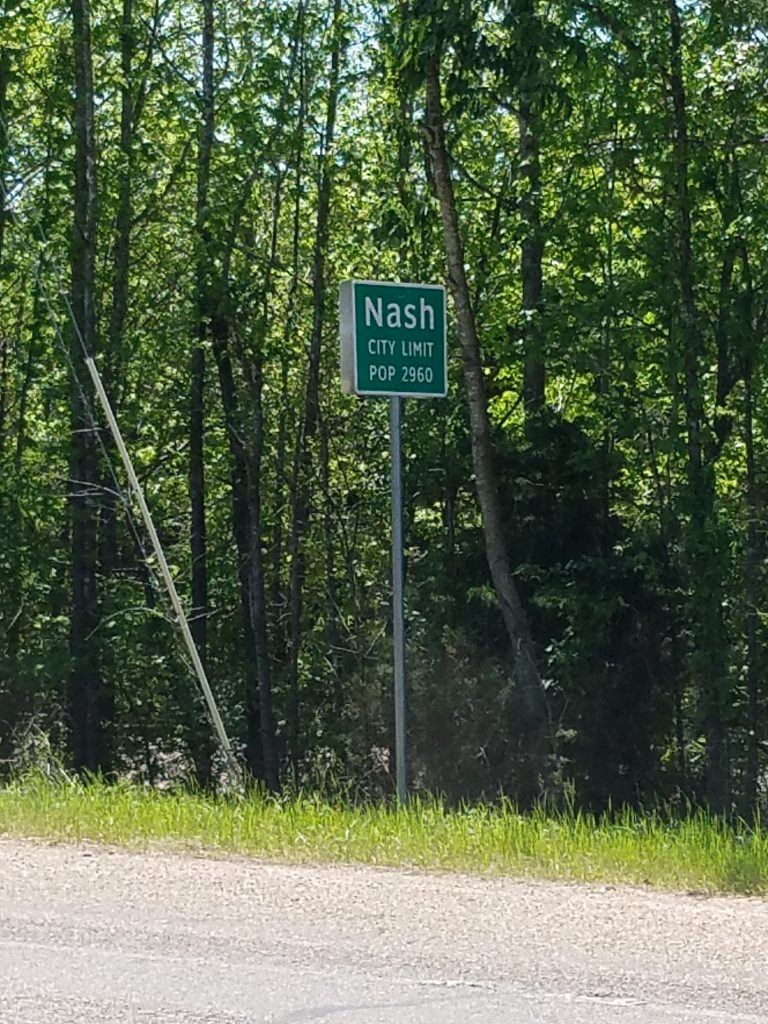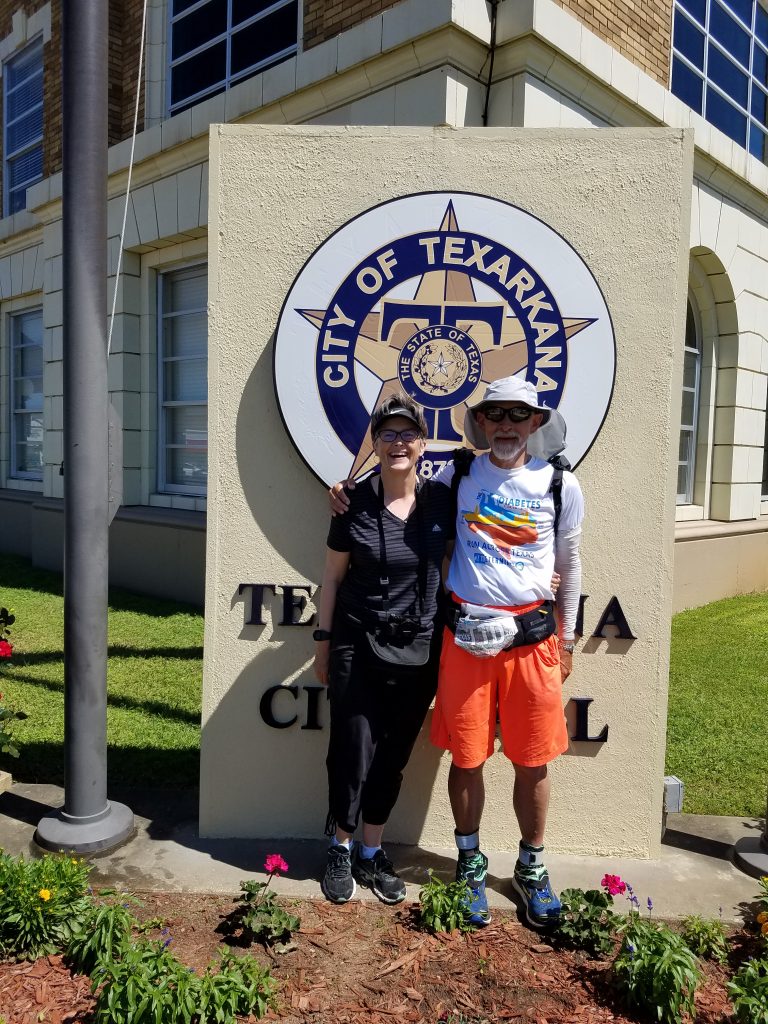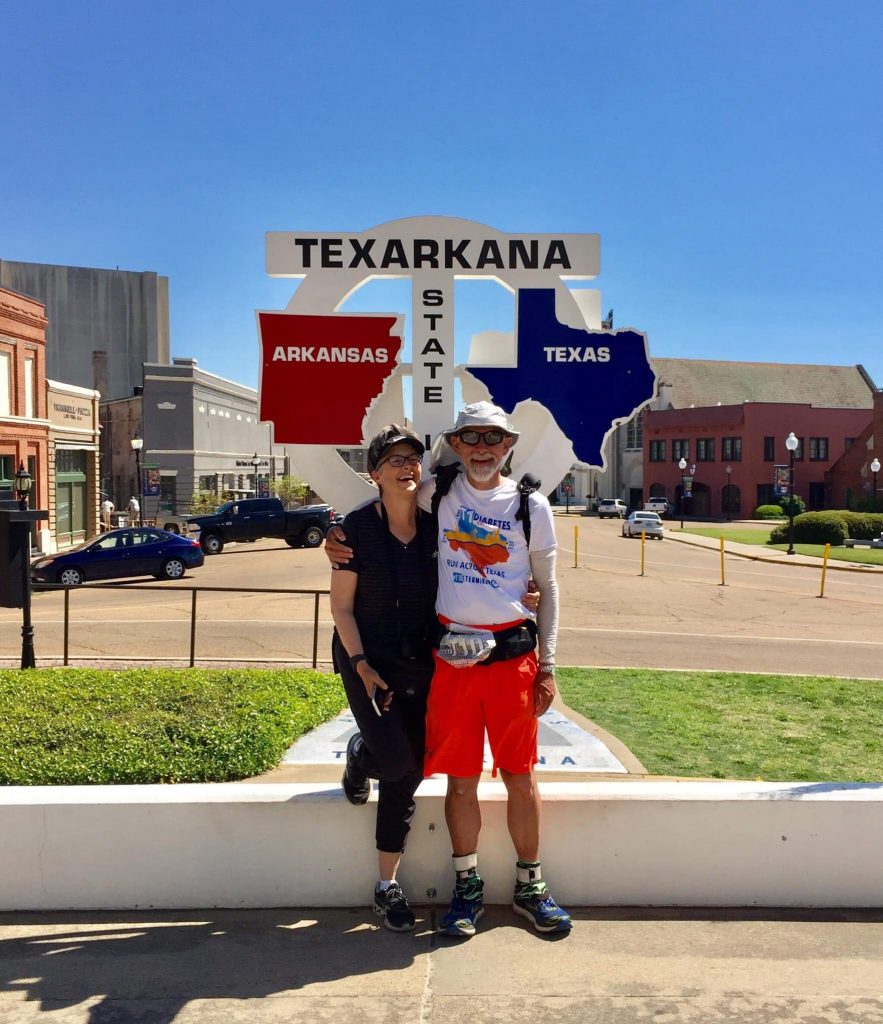Your donations help T1Determined #keepgoing.
Type 1 Diabetes Run Across Texas – Event Report
This is going to be long, because, well… I was gone a long time. But I wanted to get down into words what it was like to run across the largest state in the continental US — gnarly parts and all, while I still remembered most of it. Some of this will be diabetes related, and some of it is just about the run.
We planned a route that was the safest we could find — avoiding one way roads where neither I nor my wife / crew chief Leslie Nolen could see behind ourselves, following a hierarchy of roads based on our assessment of safety. In fact, we were safety obsessed: I hardly ever ran in total darkness, preferring daylight first, then dawn and dusk, then — if necessary on 40-mile and longer days, first and last light. That said, when visibility was in question I wore an LED Light Vest and bright yellow and orange clothing from SeeMeWear most of the time.
Before I get into details of the days, I should mention that our team went to great care to document the run. We carried a Garmin InReach tracker and a Suunto Ambit 3 GPS watch, both of which experienced faults during the run. In the vicinities of Odessa and Weatherford, my InReach decided it wasn’t going to record part or all of the day’s track. Fortunately I had that recorded on my Suunto Ambit 3 GPS watch. But then the Ambit 3 decided at one point on the Cottonbelt Trail in Colleyville to stop my workout at 200 total hours and 625 miles (the “1000K bug” is something Suunto watches just seem to experience–it happens on my Suunto 9 Baro also). I immediately started a new one before making any further forward progress, but this set me off and kind of ruined my day, as I had been taking photos of my watch to celebrate progress. I took timestamped photos of County signs as I entered each county, and when I had a pacer, had the pacer take the photo.
Day 1 – El Paso to Hueco Tanks – March 24, 2019
In our route planning, one of the considerations was how far to run each day, so that when we ended the day, we hadn’t pushed my legs too far, run very much at night, and wouldn’t have to drive very far to accommodations. Keeping the average daily mileage in the neighborhood of 35 miles meant that I could get a decent hot meal before any eating establishments closed, prep gear and clothes for the next day, and enjoy some recovery time.
Just about every day we got up around 6 AM in time for a 7 AM departure, as close to sunup as we could. Our original timeline called for starting each day’s run at sunup unless the miles couldn’t be completed at my estimated 18 min/mile pace (including breaks) before sundown. But sunup varied each day, and it got to be a nuisance setting my alarm for weird times like 6:02 AM or 5:48 AM, so after the first day we fell quickly into the routine of starting the run at 7 AM.

On Day 1, we started at 7 AM at San Jacinto Plaza in downtown El Paso. I was accompanied at the start — and for the first 110 miles and 4 days — by Eric Dutcher, a fellow type 1 diabetic and Tough Mudder. We were supposed to meet with a TV crew (didn’t show up), and with the El Paso Diabetes Association (didn’t show up), so when we arrived at the plaza, we took some selfies and video.
Day 1 was targeted for 26 miles. We ran south from the Plaza to our first turn at Texas Ave. (Ironically, our last turn in Texarkana was Texas Blvd.), then north on Cotton St., and east on Montana Ave. Civilization slowly fades away going east, but for most of the first day, it was city running with its share of convenience stores and restaurants.
We had lunch at the Whataburger in Homestead Meadows and began our daily routine of keeping lunch to 30 minutes or less. That more than anything kept us on track time-wise.

The day ended at the Hueco Tanks turnoff at RR-2775, just past Butterfield. We drove 5 or 6 miles north to an Air B&B and met Eric at the turnoff the next morning to continue the run.

Day 2 – Hueco Tanks to Cornudas – March 25
Most of the run to Cornudas was uphill, or at least seemed that way. US-180, which Montana Ave had slowly turned into, had a wide shoulder with very little gravel, which made for good running on fresh feet. I would learn to love the gravel as the run wore on, but I was pretty happy. Day 2 was scheduled to be 37 miles, so it was a bit challenging for Eric to run uphill for 37 miles in the west Texas sun, but he adapted well to it and did a great job pacing me. I have a tendency to “double down” when faced with a hill, or wind, or some other challenge, and then never take my foot off the gas, which tends to wear me out. So having Eric pace me kept me to my intended run-walk-run plan and we covered the miles at a good pace. As I recall, we may have finished an hour early, as there wasn’t much along the route to stop for.

We picked Cornudas as a place to stop because, well, it’s the only place you CAN stop between Hueco Tanks and Dell City. There’s a lone diner called Cornudas Café that’s absolutely covered in visitors when it’s open. That café pretty much IS Cornudas. It has restrooms, and despite being little more than wide spot in the road and not that close to our Air B&B in Dell City (about a 30 minute drive), it was the only place that made sense to end the day. Again, we were making a good pace and finished about an hour early, owing primarily to the fact that I was making about an 18 minute pace with breaks, rather than the 20 we had planned on. We finished in Cornudas around 5:30 PM as I recall. Dell City had a general store with pizza (Dell City Mercantile), and after ending day 2, we arrived about 15 minutes before the store closed at 6 PM.
Day 3 – Cornudas to Abandoned Greyhound Station at Salt Flat – March 26
Cornudas to the Greyhound station was mercifully short: 24 miles, and we took advantage of the time to top off the van’s gas tank. We were paranoid about the lack of gas stations between Dell City and Orla, a stretch of about 150 miles.
By now, Eric’s arms were getting cooked in the sun despite the generally cool temps (notice my long sleeve shirt) and he broke out his arm warmers to keep the sun off them. Temps in the morning in west Texas in late March actually verged on cold, and it was fairly common to start at 7 AM in a windbreaker and long sleeves, and by 9 AM be out of the windbreaker and by 10 AM have changed to a short sleeve shirt. Eric’s neck was also getting sunburned, and the photo below was the last day he ran without neck cover.

Day 4 – Abandoned Greyhound Station to McKittrick Ranch Safety Rest Area, Pine Springs – March 27
Day 4 was… different. It was 33 miles — not too hard for me — but uphill like day 2. In fact, between mile 18 and 20 from the abandoned bus station we encountered the steepest ascent: the run up to Guadalupe Pass. As we transitioned from Hudspeth to Culberson County, my pacer Eric and I crossed the 100 mile mark. It was the farthest he’d ever run. His father was a geologist, and Eric explained to me what the markings were on some stone outcroppings we encountered along the route. It gave us something to talk about, and the time passed swiftly. We spotted a weird boulder in a field with the word “Death” painted on it, and that day I encountered 7 white butterflies and a discarded bra.
The steep uphill led to what I call the beginnings of “road climbing” blisters on the tips on my toes and the first proactive foot-taping of the trip. The blisters didn’t fully materialize, and the two of us made it to the top of the pass, where Eric and I parted company, he hitched a ride to Carlsbad with a woman who looked just like Sarah Connor from Terminator, and he returned to DFW.
Eric should have said “I’ll be back” in an Arnold Schwarzenegger voice, because he rejoined me many days later in Wylie, TX to run another 8 miles.
After the pass it was mostly steep downhill, and I had to lean back to stop myself from breaking into a run I couldn’t stop. We ended the day at the McKittrick Ranch Safety Rest Area just west of the turn onto TX-652 and right before the time zone change from Mountain to Central. We were glad to cross that line, as the difference in time zones had us all dreaming that we’d start an hour late or early and end up running Guadalupe Pass in the dark with oilfield trucks buzzing us.

Day 5 – McKittrick Ranch Safety Rest Area to Delaware River – March 28
Day 5 was 25 miles. I originally considered running the stretch from McKittrick to Orla all in one 50-mile lump, but I didn’t relish a long run followed by another long run FROM Orla, with little chance to recover, a good chance of running in the dark. So I split it into two days after test running that part of the route in November 2018.
This stretch was mostly downhill. It was nice to have a short downhill day, and I had found a comfort zone gear-wise that I kind of stuck to once I got through the pass — short sleeves and arm coolers for most of the day except the cold morning. They actually kept me warm, and I couldn’t tell I was sweating very much. The windbreaker seemed like too much after a couple of hours.
The good news is that there isn’t much between Guadalupe Pass and Orla to distract you. The bad news is there isn’t ANYTHING there to distract you.
Nevertheless, I found things. Beautiful sunrises, interesting road trash, and some nice vistas. I met Scott Towle, a fellow Type 1 who was on his way to Guadalupe Peak on a recreational trip, who stopped just to say hi right near / before the turn to TX-652. That really pumped me up. I also magically encountered a purple porta-potty at a “water station” that miraculously appeared after I entered Central Time Zone.
The only thing that convinces me it was real is the photograph. Remember, this is the part of Texas where people paint the word “death” on rocks, put post-it notes on rocks, and take off their clothes.
We chose the Delaware River, in actuality a dry gulch of some size that I am sure floods during the rainy season, because it was the only landmark we had. We debated starting at the Chevron Delaware oilfield, but we didn’t like the idea of setting up our start on private property, only to be told to keep it moving.
Day 6 – Delaware River to Orla – March 29
A very straight 25-mile stretch of highway for the most part with decent shoulder and not a whole lot of oilfield traffic, and what there was tended to be low-speed, pulling out of actual oilfields. We took heat breaks when we needed to — which wasn’t all that often due to the dryness. Chapped lips were more of a problem than sunburn. We spotted the occasional stalwart desert flower and it improved my mood.
As I got closer to Orla, nearly ANY traffic kicked up dust.
This was where I learned to take the dust seriously. I started regularly wearing an American Diabetes Association neck-buff I pulled out the day before, which I had gotten as a freebie on a bike ride, and pulled it up over my nose to keep the dust out. I didn’t learn until later that it’s also wise to wear leg coolers, as without them, even with an abundance of sunscreen, you will finish the day with raw legs due to windblown sand. After two scouting trips and a dry run, I decided to buy a pair of DeSoto leg coolers. I love DeSoto, but the leg coolers fit horribly and the silicone grips left welts on my thighs, so it was a love-hate relationship. I took to wearing them alternate days to give my skin a chance to heal.
We got into Orla on schedule around 5:30 PM (after all it was only a 25 mile day). The wait for a shower was close to an hour and a half, and by the time we bought a pizza and ate supper in the van, we lost a fair bit of time. We set up the rooftop tent close to sundown.

I did not sleep particularly soundly. But the truck stop in Orla is literally the only civilization for 150 miles, so you don’t complain.
Day 7 – Orla to Mentone – March 30
I expected this 27-mile stretch to be more daunting than it was. I had been warned that US-285 was a very busy road that I should not run on. But then so is every other road in west Texas. It turned out that most of US-285 is under construction (widening), so there was an entire two-lane, sometimes freshly paved, some times packed gravel, side of the highway entirely off limits to traffic for the entire day. In a few spots were mounds of dirt made by earth moving equipment, but other than that it was fairly pleasant. Because it was a busy US highway, I got a little frustrated about the frequency of private moments to tend to biological needs, but there were occasional pulloffs that made a primitive restroom stop in the van practiceable. Nevertheless, I was glad to get off that stretch of road.
Just before Mentone there’s a turnoff to TX-302. THAT was actually the busiest stretch of highway, where I encountered a small town that seemed to exist only as a postal drop station for oilfield workers. This was also where I encountered abundant goathead thorns, some very thorny (.5-.75 inch length thorn) bushes (creosote, I think), very narrow shoulders and crazy fast oilfield traffic that seemed to be full-on by 6:45 AM. I wore my night gear well into the morning just so I could be seen, and ran far from the shoulder, in the grass and weeds near property lines, when I could. We were told by individuals that the ruts I was running in were actually left by impatient truckers.
Day 8 – Mentone to Kermit – March 31
33 miles. But what a 33 miles it was.
I learned from a transconner friend of mine, Terrie Wurzbacher, that there is something called “sympathetic nervous system overload.” It’s just a couple notches down from PTSD. Running in oilfield country can give you that. Mentone to Kermit was my first encounter with really awful traffic on what looked like quiet roads during our route scouting. Trucks with oversized loads on a two-lane road traveling at 70 mph felt like living in one of the Mad Max movies. You learn to look up frequently, stay well off the road, run like hell, and listen for traffic, as it’s not uncommon for a large truck to be passing another large truck behind you and be well into your lane and near the shoulder.
If you’re taking this route on your own trans-Texas run, get through these next two days as fast as you can.
I was incredibly glad to finally reach the first outpost of civilization, Kermit TX, after a harrowing 33 mile day. Kermit has a nice hotel, the Southern inn and Suites, and real restaurants. If you’ve ever run distances like these, you know how important it is to connect with something besides your water cooler, crew, and the endless supply of chicken salad, yogurt, and reconstituted dried beef you eat to replenish protein. Each day at lunch we took a 20-30 minutes (usually 20) break during which I ate a hot meal my wife / crew chief prepared on a camp stove or Barocook. Don’t get me wrong — she is an AMAZING camp cook — but it’s the sitting down in air conditioning and being able to get up and go wash your salt- and sand-encrusted face in an actual sink that I craved.
Day 9 – Kermit to Odessa – April 1
41 miles. The oilfield traffic was very bad on TX-302. We were already concerned about running a 41 mile day on the roads we had been on. Shoulders were narrow, traffic was loud and fast, and we were warned multiple times that the road was dangerous. I was nervous that out of concern for our safety the police would take us off the route and we’ve have no claim to have crossed the state in any orderly fashion.
We began to reexamine the route to see if we had missed a safer alternative. We had not. Not wanting to deal with being relocated, I ran at a very fast pace for a very long time. I kept meal breaks to the absolute minimum because there weren’t many safe spots to stop.
As a result, my blood sugars ran persistently low for most of the day. It was difficult to get them above 90 mg/dl, considered normal for a non-type-1-diabetic but during exercise usually an indication of an impending low blood sugar. I ate cookies, pudding, full-sugar sodas, chocolate milk, fruit cups, and anything I could find in the van with sugar in it, to try to keep my blood sugar above a dangerously low level.
I could tell I was pushing it because I could feel a cytokine reaction coming on, which feels like the onset of the flu. I actually ran during the warmest part of the day with a jacket to keep the chills off.
I felt like I couldn’t take a break.
As we entered Odessa, a photographer from the Odessa American came out and took some photos for an article in the newspaper. That was the high point of the day. I finally slowed down and allowed myself to enjoy the fact that I had made it to Odessa, sidewalks, real food and flush toilets.
As is typical (if that’s a concept) with type 1 diabetics and endurance events, when I finished the day my blood sugar spiked well above 300 mg/dl as the stress of the day caught up with me. I dialed in the recommended dose of insulin from my insulin pump based on my blood sugar, forgetting I was extremely insulin sensitive. I also wasn’t that hungry, and didn’t eat half my supper at the restaurant in Odessa that night.
Bad, bad idea. By 8 PM, although very little of my onboard insulin had kicked in, my blood sugar was dropping fast, and I ate every sugar-laden thing we could rag out of the van. By 9 PM, my blood sugar had dropped precipitously, to 30 mg/dl, with 2 units still onboard, enough to require hospitalization without immediate treatment.
God bless Leslie. She had brought a glucagon emergency rescue kit and gave me an injection just as I was losing consciousness.
I avoided a hospital trip that night (and possibly brain damage or worse), and that was a victory.

Buuutttt….
If you’re not type 1 diabetic, married to one, or a nurse, doctor, or EMT, you probably don’t know that the way glucagon works is that it forces your liver to dump glycogen — ALL of it (or close enough). The danger in running the day after a medical emergency like this is that you have no glycogen reserves to kick in if you’re underfueling. If you don’t make ABSOLUTELY certain you’re not underfueling, the next low blood sugar episode may kill you. Many, many type 1s live in fear of what is called “dead in bed”, which is the risk I was facing if I chose to run the next day.
There was no way I was going to run the next day.
Day 10 – Forced Rest Day – Medical – April 2
On Day 10, we took our first forced rest day. I slept in, we called hotels and changed reservations for the rest of the itinerary, restocked the van with our now-depleted emergency sugar-drinks, I ate like a horse, and did my best to replenish glycogen.
The day had a positive note: because of the delay, I actually caught the article on my Type 1 Diabetes Run Across Texas in the Odessa American.

Day 11 – Odessa to Midland – April 3
29 miles. Because Odessa and Midland are really only 20 miles apart, I deliberately set this part of our itinerary to start at the Stripes in Odessa where we had ended the last day of running , as far west as I could, and end as far east in Midland as I could. That added almost 10 miles, and made the next day’s run into Big Spring a reasonable 40 miles. We ran through the city, on a route that avoided busy Business-20 as well as the highway between the two towns. That meant spending most of the day on Industrial Blvd until it ran out just west of LaMesa. At that point, I had to cross the railroad tracks to Front St., just north of Business 20, and make my way to another safe RR crossing at the east end of town. I managed to catch the crossing just before and after trains, so the traffic was not as bad as I feared. It was near the railroad that I discovered that Midland has ground squirrels! And a LOT of oilfield services companies. So many, in fact, that after searching for a better place to stop for the end of the day, we just picked one and hoped they wouldn’t mind us blocking their driveway for a few minutes while I stopped my watch and tracker for the day.
Day 12 – Midland to Big Spring – April 4
40 miles. This was my first section in the part of Texas I was more familiar with: trees and grasses instead of scrub and thorn bushes, and it felt to me like the color of the land changed. I crossed the 300 mile mark and started doing math in my head to figure out just how far past 1/3 of the way I had gone.
Signs started showing up with the distance to Ft. Worth, and while the numbers were incredibly daunting, they were less than the distance I had gone. There were still a lot of oilfield trucks and oilfield service businesses, but I began to see them as less of a threat. A number of them had porta-potties. It seemed to me like the county signs came closer together, and it felt like I had left the Mad Max part of the state.
Roads had shoulders again, and there were more of them. Our team had chosen to follow the two-way local roads that fronted the Interstate so that we could take advantage of the little clusters of businesses that popped up near the highway without actually dealing with Interstate traffic.
And while it was a 40-mile day, it didn’t feel like one. Gone was the urgency of getting away from the oilfields, replaced now with my own dogged persistence. I was still maintaining an 18 minute pace with breaks, and had hung onto the habit of cutting lunches to 20 minutes, so we still ran a bit ahead of schedule.
Up until Texas, the longest run I had ever done was a solo run of Relay Iowa, 339 miles from Sioux City to Dubuque. It had been grueling. My feet had swollen, and blisters had set in by mile 300. During the Texas run, I had no significant blisters or hot spots as of mile 300, and I started to feel optimistic that I might make it halfway across the state at least.
My blood sugars continued to run high, and I was reluctant to dose them down too aggressively after the episode in Odessa. My wife and I attributed this to the continued stress of running 35-ish miles a day on a regular rotation, and we noticed my sugars tended to spike when it was hot, hilly, or traffic was bad, which tended to confirm our hypothesis. There wasn’t much we could do about it, so we tried to manage my stress level. Sometimes it worked.
One thing that raised my stress level was that after quite a bit of planning prior to the run, we discovered during a scouting trip that Cauble Bates road into Big Spring was closed. We had to detour north on CR-2599 and then southeast on CR-137, which added some miles. By the time we started my run in El Paso, we had already worked that into our route and while we weren’t happy with it, we had managed to take some miles out elsewhere and keep the total around 850.
When I arrived at the outskirts of Big Spring, feeling tired and losing sunlight, we discovered that our bridge across I-20 had been demolished. Fortunately the two-way local road on the north frontage had a safe shoulder a little further east on US-87, where we crossed to our day’s-end stop.
Of course the stress caused my sugar to shoot up like a rocket.
Day 13 – Big Spring to Colorado City – April 5
Big Spring to Colorado City was 41 miles. Doing a 40 followed by a 41 was tougher in my mind than it was in reality. We began to see that there was a rhythm to our days. The 30-35 mile days seemed to come easy. We wrapped them up quickly, did laundry and shopping, and got extra sleep. Sometimes we allowed ourselves to start at 7:30 instead of 7 AM. We retaped my feet or tended to other tasks that took time out of our day. The 36-38 mile days were the most common, took more of the day, and those I felt confident we could finish well before sunset, but our “wiggle room” for the day was smaller. I felt very conscious of every stop to check for rocks in my shoes — which thankfully wasn’t often because I had worn gaiters to keep gravel and road grit out.
The 38-and-up mile days required some discipline to finish before sunset.
We allowed ourselves a hot lunch at the Dairy Queen in Coahoma, which apart from a gas station is Coahoma’s only attraction. The DQ had two cats who seem to have adopted the store. We had encountered them back in November when the kitten was very small and the mother was very protective. Now the kitten was grown to almost the size of the mother and had a very independent, friendly attitude. It was sweet to see the two of them again, and it felt like we were back in familiar territory.
We started to see these beautiful yellow wildflowers growing at the edge of the highway and just a smidgen of bluebonnets, which despite all the hype are really a central and east Texas thing.
Weather forecasts predicted rain in the evening, so we were anxious to finish before dinnertime. We left town at first light and pushed to keep our breaks short.
At around mile 380,just as we were coming into Colorado City, my feet began to bother me. Despite the proactive taping, I developed the first of 3 blisters on the inside heel area of my right foot, a place I don’t usually develop blisters, and on the middle two toes of my left foot. I attribute some of this to road camber and the unusual gait it had subtly forced on me. After taping, my feet felt better and we pressed onward.
We made it to the Just Stop a little before sunset and stopped at Kelley Café, an old converted elementary school, now a restaurant, run by a lady named Brenda, who was a former teacher at the school. She had bought the whole building and converted the cafeteria and auditorium area into a massive restaurant that served some fairly nice food. I had some kind of meat dish with vegetables that was really good and reminded me of the meal I had had in Odessa before things went south with my blood sugar.
The meal went on way longer than we had planned, but my stress levels dropped. And promptly as we headed to the car, the bottom fell out of the skies. We drove back to the hotel with hail banging off the roof of the van.
Day 14 – Colorado City to Sweetwater – April 6
Colorado City to Sweetwater was a blissfully short 28 miles, but after the rain it was humid, and around 9 AM it started to get muggy. We passed through Loraine, a town distinguished mostly by the full-grown trees that had sprouted up inside what remained of the town’s center. I passed the 400-mile mark some time during the day, and in Roscoe, I believe it was, there was a little picnic area with tables where we sat down for a shade break.
I saw more and more bluebonnets, and as we reached Sweetwater I was amazed at the number of Detour signs — though thankfully this time the roads we wanted were good and we encountered no more demolished bridges.
We had previouslythought about taking our route through town, but during scouting trips it felt like the south side of Sweetwater was a big seedy, and it was difficult to find places to cross the railroad. Therefore, our stop for the day was a Phillips 66 at southeast Lamar and I-20, which was easily accessible from the two-way frontage / local road bypassing a good bit of the town.
Day 15 – Sweetwater to Tye / Abilene – April 7
34 miles. I didn’t really need to head out at dawn, but by now we had fallen into the habit of rising at 6 AM and heading out the door around 6:40, usually starting our run at 7. Sometimes, as was the case leaving Sweetwater, the hotel wasn’t far from the day’s start, so we took in some good sunrises.
Sweetwater seems to be the Town of Detours. I was amused as I headed out to see a detour sign directly across the highway from a Motel 6. I kept thinking, “Well played, Motel 6, well played.” It brought a smile to my face.
For some reason, Trent really sticks out in my mind. The town has only 318 people, which is small even by rural Texas standards, but it seemed more alive than Loraine or Roscoe. It had a convenience store that was our flush toilet stop for mid-day. I left in a good mood.
I felt like the low blood sugar episode in Odessa was well behind me, and it seemed like I might actually make it across the state. We were headed into Tye / Abilene, our first big city after Odessa / Midland, and we were supposed to meet a TV crew from KRBC/KTAB the next day. My feet didn’t bother me much, and my sugar, while constantly around 250 mg/dl by now, seemed to have stabilized in that range and I wasn’t feeling too worn down by it.
My ultra running friend Rochelle Frisina, whom I was luck to meet later in Grapevine, TX, had warned me before my run across Iowa about emotional volatility on long runs. I wasn’t sure whether it was that or just being in a good mood, but I was really happy to get to our day’s end stop at the Alon / 7-11 at Scott and North.
Day 16 – Tye / Abilene to Baird – April 8
31 miles. It was cold the morning of April 8th as I headed out from the 7-11 in Tye, along the remains of the old Bankhead Highway, which was now South St (a continuation of North St., don’t ask). Like a lot of mornings on this run, I didn’t really have to use the restroom until I was all suited up. At this particular gas station, there was one in the back but the cashier didn’t seem particularly interested in letting me use it. This pattern repeated itself as I left Tye and headed through Abilene. I learned later in the day that it’s because Abilene has a heroin problem, and they don’t want people shooting up in the bathrooms.
As a type1 diabetic, I felt a bit singled out by that particular exclusion, but I let it slide. As I crossed Business 20 to Steffens and followed the curve to the Arnold Blvd frontage road toward the gas station on 7th marking my turn toward Abilene, I was upbeat about meeting Jessica and the TV crew from KRBC/KTAB for some running shots after the interview outside the hotel.
7th street was a bit busier than I remember from the scouting trips, and the weeds were tall and there was no frontage on this four-lane road, so my shoes got a little dewy despite the gaiters. At least, though, I was well out of the country of goat head thorns and creosote.
Sidewalks and shade seemed to kick in alongside houses a few blocks west of Treadaway. I remember a little donut shop on the SW corner of a street I can’t remember any more, where I bought an apple fritter and borrowed the restroom — the first such stop there seemed to be in Abilene after 3 unsuccessful attempts at finding one in a gas station. I also remember a record store, then an open gravel area where Leslie pulled the van off and cooked a hot meal. I no longer remember if it was breakfast or lunch. I enjoyed the shade and being in a big city for a while. Then we got going again. The sidewalks gave out around the Lytle steak house as I headed toward the Abilene Zoo. It was warming up by then and I was a little disoriented. I called Leslie for directions, reoriented, and crossed under the Lake Roberts Freeway, turned onto CR-18, and soon I was back on the usual country roads paralleling I-20.
There was a paved road leading into a yet-to-be-built development just off CR-18, and as the day was hot, we took a quick break for liquids and continued to Elmdale Rd. What I remember of this section was that it seemed baking hot, although it was probably only in the high 80’s. The gas station marking our turn seemed to be very far away.
There was an actual rest stop about 3 miles after we returned to the vicinity of I-20, and we had lunch in the shade and breeze. That helped perk me up a bit, as I had been dragging ever since the Abilene Zoo.
I was glad when we got back to the roads paralleling I-20 and the familiar pattern of big rolling hills.
In fact, all I remember about this day is the hills. Endless hills on the road paralleling I-20. Late in the day, a stranger stopped me and asked what I was doing, and I explained that I was running across Texas to raise diabetes awareness. He pointed to the next big hill and told me it was the biggest hill in Eastland County. I didn’t need to know that.
I hated the uphills with a vengeance and just kind of gritted my teeth on those. There were also lots of low water crossings, some that had to be trekked around rather than walked across.
The downhills were sweet, though, and I managed to cover more distance somehow on these roads than I could on flat ones like CR-18.
We ended our day at the Love’s Travel Stop in Baird, got in the van, and drove back to White’s RV Park in Clyde, about 7 miles away, where I was befriended by a cat after (s)he decided I wasn’t much of a scratching post. The cat kept trying to get into the van and eventually lost interest after we turned in for the night.
Day 17 – Baird to Eastland – April 9
37 miles. More hills. I started taking photos of the hills to prove to my friends just how hilly Eastland County was. Then I stopped. It was nothing but hills. I knew this from the scouting trip, but there’s a difference between looking out the car window and saying, “OK, some hills here” and actually running them.
After a while I reached Putnam. It may have been a lunch stop; I can’t remember. We passed through Cisco, which had hotels, food, and the like. And of all things, Tesla charging stations! But it was too early for a stop, so we continued on as planned.
I hit 500 miles. I should have been more excited, but I kind of just took a photo of my watch and moved on. The miles to Ft. Worth were slowly eroding, and every road sign showing a smaller amount of miles brought encouragement.
The hills went on, and then kind of gave out for a bit as we neared Eastland. I remember the turn at the Shell Station on CR-6, also known as Burkett. The shoulder was wide but the road seemed to go on forever. My feet hurt, and as we reached the Brookshire’s at the center of town, I kept thinking “almost there.” But there was another mile or so to go, and that mile seemed to stretch into infinity. At least there were sidewalks. I sat down a lot. It felt to me like it was getting late, but it was probably only 6 PM.
It seemed like a lot more than 37 miles. At least the day’s end was at the hotel where we were staying, so that meant no drive to the start and no wasted time in the morning. Perhaps I could get a little more sleep.
Day 18 – Eastland to Strawn – April 10
30 miles.
We had already planned a route that avoided getting anywhere near the dangerous piece of Interstate near the Eastland County Safety Rest Area, instead taking roads through Ranger (254, 717, and 207). The road into Ranger was downhill, and I made it six miles from the hotel before Leslie and the crew van caught up with me. I found another porta-potty, visited Ranger’s limited downtown, and I felt a little sense of victory.
It was short lived. 717 was narrow, curvy, had few places to stop, and was mysteriously peppered with signs saying “forbidden zone.”
We were originally supposed to stay at the Thomas House, a historical home converted into a B&B, but about a week before we called to confirm our reservation, the lady who answered the phone said that there had been water damage and that they wouldn’t be open for another month. That meant we had to drive about 8 miles to another RV park and endure mediocre sleep. We decided once we reached the junction with TX-16 to drive back to the la Quinta in Eastland and stay another night. That meant a 30 minute drive, waking up 30 minutes earlier, and 30 minutes less of prep and sleep time on the front end as well.
The road into Strawn wasn’t a bad one, but that was the hottest day of our run (temps in the 90s) and I had steady headwinds of 20 mph, gusting to 34-40. It was also incredibly hilly. Not big rolling hills like those near Baird, but little irritating steep things that jumped up when you weren’t looping and took out all your motivation.
Upon ending the day in Strawn, we hit something on the road driving to the hotel in Eastland — I’m still not sure what — and it ripped a good-sized section of the skirt from under the van. It hung loose and flapped as we rode toward Eastland. Believe it or not, we had duct tape in the van, and being from Mississippi originally… well, we know how to use duct tape. We stopped on TX-16 and made some improvised repairs. The repair held for the rest of the run, but diagnosing and fixing the problem wasted a lot of time.
I was in a pretty bitter mood at the end of the day, buoyed only by the thought that next was Mineral Wells, a meeting with the mayor, another newspaper interview, and best of all, fast food and flush toilets.
Day 19 – Strawn to Mineral Wells – April 11
36 miles. Palo Pinto County is sometimes called the Gateway to Texas Hill Country, because it’s where the hills began if you’re going west or southwest from DFW. I hit some of those hills, but because I was leaving the hillier part of the state, it felt like most of the county was downhill. I came across a stretch of orange and yellow flowers that mimicked the colors of my jacket, which I continued to wear partly because of the wind and partly because the stress was giving me a slight fever.
I ran past the remains of a forest that had burned a number of years ago. The area still smelled like ash.
Here and there we saw more signs that we were still traveling the route of the historic Bankhead Highway, the first all-season transcontinental road in the U.S., built back in 1918, and now, like its better-known sister Route 66, fallen largely into disuse except for the occasional stretch of badly-patched concrete or asphalt.
Somewhere along US-180 as we approached Mineral Wells I encountered a picnic area. I sat down in the shade for a few seconds just to say I had sat down in the shade.
Some time later I cam across a famous “ghost bike” where a cyclist known in the area had perished in an encounter with a car.
Finally, I reached Mineral Wells, civilization, and the beginnings of the Mineral Wells to Weatherford Trail. The trail goes quite a bit out of the way and really isn’t the shortest path between the two towns, so I ran along US-180 the next day.
For now, though, it was time to enjoy a good night’s sleep, courtesy of one of my favorite towns in Texas.
Day 20 – Mineral Wells to Lakeside – April 12
38 miles. We adjusted our end point for day 19 to stay at the Best Western instead of the Days Inn, as it was more convenient for the mayor. On the morning of April 12, we met Christopher Perricone around 6:30 AM, about half an hour before setting out. It turns out that he’s a pretty cool guy — a runner himself, and he was very interested in the run we were doing and the charity participants. We talked about the fact that I trained on the rail-to-trail conversion between Mineral Wells and Weatherford, and what I liked about the town and what I looked forward to during the day.
It was going to be a busy day, as I planned to meet with a reporter from the Mineral Wells Index along US-180 somewhere, having told him that I couldn’t stop for long and that it might have to be a walking interview. After that Leslie and I were supposed to meet with a reporter from the Weatherford Democrat for some photos to go with a story she had written before my arrival; and with Lori Tollett, whose grandson had been diagnosed with type 1 at age 1.5 and was now 5 years old.
The Tolletts and Leslie and I met at the Malt Shop. Stratton (the kid) was a warrior — we showed each other our Dexcom continuous glucose monitor sites and exchanged fist bumps. I ate half a cheeseburger and most of a kiddie-size root beer float, which I probably did not need. That took up our long breaks for the day, which we exceeded by 15 minutes, meaning that my arrival at Lakeside would very likely be in the dark.
Once I turned north off US-180 onto FM-730, the roads got quiet again, and for a while, through what appeared to be a relatively suburban neighborhood, the shoulders were great.
I hit mile 600 somewhere near Azle, TX, while the shoulders were still nice and it was daylight.
When we turned east onto Confederate Park Blvd, The roads were narrow, full of blind hills, and it was getting dark as I got closer to the end of the day’s running. I pushed past sunset for the first time on the run, until I started to make missteps near steep culverts. I don’t like to run at night anyway — though I’ve willingly done it during the run across Iowa as well as a 200-miler in south Texas. It hypnotizes me, and at least for me, I tend to feel a bit down and pessimistic when running at night. Probably a hormonal thing. Anyway, I arrived at the A to Z grocery in either Azle or Lakeside (there’s only one — I just can’t remember what town it’s officially in), about 2 miles short of our goal for the day, well past sundown, and decided to move those 2 miles into the next day, which was supposed to be just 31 miles.
As Leslie and I checked the weather, though, things weren’t looking good, and later that night I discovered that my Garmin InReach had decided not to record ANY tracking points for the day.
At least I had my Suunto’s running total for the route, which was more or less accurate. The Suunto has a habit of grabbing random points miles away and “beaming” you there for a few seconds, and I had noticed that my miles were creeping ahead of my actual distance on our turn-by-turn sheet. On long days like the one to Lakeside, I would find myself eagerly awaiting arrival at a turn or landmark only to be told that according to Google it was still 1.5 miles ahead. At least I could count on the watch recording the course I took, aside from those rare glitches. But it put me in a sour mood.
Day 21 – Forced Rest Day – Weather – April 13
By the time we had our second forced rest day, things seemed a little easier. I could run if I wanted to, but the forecast was for severe thunderstorms, heavy rain, and hail. I had run in 4 separate thunderstorms during my run across Iowa, often waiting until lightning strikes and the accompanying thunder were so close they scared me into getting into the van. Looking back, it was a stupid thing to do. Our van got hailed on, and I was lucky it wasn’t me at the time. There were tornado warnings, and at one point race director Bill Raine pulled relay runners off the course for safety.
I didn’t mind running in the rain, and heading into the Texas run I had figured we might encounter some. I hadn’t set any kind of time deadline on my own event in Texas, and the main drawback to taking a rest day was not the weather — which at most might have delayed things a few hours, but the fact that the entire day was supposed to be iffy with thunderstorms and that meant calling all the hotels downstream and changing the dates on our reservations.
This time I didn’t have the specter of glycogen depletion hanging over me, so I convinced myself to swallow any feelings of guilt about not running; and I took the time to rest up, eat a fair bit of protein, and accompany Leslie to restock the van.
Day 22 – Lakeside to Grapevine Mills – April 14
Day 22 was supposed to be a 31 mile day, but I added 2 miles from the previous running day due to late arrival in Lakeside. I picked up again at the A to Z grocery on April 14th at 6:30 AM, starting before sunup and hoping to complete the two miles from the previous day and get across the busy bridge at Jacksboro Highway before any kind of traffic set in.
My longtime friend Jeff Kilarski — and this is the kind of friend you’d donate a kidney to — met me at the Shell station that had been my original destination from the previous day’s running.
Jeff ran with me 26 miles that day, through a number of turns along thankfully quiet backroads and neighborhood streets to the start of the Cottonbelt Trail multiuse path in North Richland Hills, which allowed us to avoid a lot of busy traffic on TX-26. Jeff and I continued to the Krispy Kreme at TX-26 and Pool Rd in Colleyville, where I met Julie Kuehn (who I would willingly give the other kidney should it come to that), who ran with me and my friends Clinton and Martina until the trail ran out just west of Grapevine.
The presence of good friends made the miles pass quickly.
At 644 miles, in the middle of the Cottonbelt Trail, my Suunto Ambit 3 GPS watch decided that 200 hours was the longest workout anyone should do. It saved my workout — and I noticed before I could go another mile — but it threw me off my game. I could no longer take meaningful photographs of my watch face without explaining that you had to add 644 miles to the total. I no longer could look forward to glancing at my instantaneous pace or any other average or cumulative statistic for the run without doing mental math or getting out a spreadsheet after the run.
Late in the afternoon, I got separated from the crew van due to a miscommunication on my part, and the whole day left me both elated to see friends and unsettled about tracking my progress. But it was a relatively short day, the next day was also supposed to be a 31 mile day.
I was determined to mark my progress, so Leslie drew me a sign marking 650 miles progress once we met at the end of the Cottonbelt Trail.
By now I had developed a slight limp. It’s hard to say what was behind it. For years I’ve had fasciitis around my left distal metatarsal that causes me to have to take 10- to 20-second sitting breaks occasionally to relieve pressure on the joint. But it wasn’t that. I began to feel tightness in my instep, my left ankle was beginning to feel the effects of running on cambered shoulder, and my right leg was not liking being the whipping boy for my abused left foot. It was now showing a tendency to just sort of give way if I came down too hard on it, or surprise me with sudden little twinges of minor but nonetheless sharp and startling pain.
All of that left me a bit worried when I sat still too long that I might not do so well when I got up again.
Day 23 – Grapevine to Wylie – April 15
31 miles. This was probably my 2nd favorite day of the whole run. I started the morning by meeting one of my heroes, Rochelle Frisina, an ultra runner who was the first person to complete the 223-mile Capital to Coast Relay solo, as I had done a few years later in 2017. Rochelle had coached me on what to expect from a 200+ mile race, including not just the wear and tear on one’s feet, but the fatigue, depression, and effects of sleep deprivation, including emotional fragility and volatility and occasionally, hallucinations. Per her advice, I had taken great care on my run across Iowa and on the Texas run to eat lots of protein, get as many hours of good sleep as possible, and to get off my legs when I wasn’t using them.
The day was short, and like the previous, I encountered friends. Frankie Agius, a Facebook friend who ran 8 miles with me. Tim, my wife’s hairdresser, who had encountered me by chance. Dave Cashman, a good friend who took off work and waited on a street corner along the route with water and electrolytes, not knowing when I’d arrive.
I ran within 8 miles of my house, and the pull was strong. After a while, I snapped out of it and continued on. Then late in the day, Eric Dutcher — you remember him as the guy who ran the first 110 miles with me — surprised me as I approached Murphy Road in Murphy (hey, I don’t make up these names, somebody else does). Eric ran the last 8 miles of the day until we reached the Kroger at Country Club Road in Wiley, where we’d start the next day. Most of the run was on sidewalks and in a civilized area, so I didn’t feel too nervous about food and restroom stops.
By my math, once I reached the Kroger, which was around 680 miles, I had officially run twice the distance across Iowa, a state I had run across in 2018 as the first solo runner of Relay Iowa. Somehow, that felt like a completion of something, like bragging rights that would stick even if I didn’t finish Texas.
I was beginning to feel the effects of the distance, though.
Day 24 – Wylie to Greenville – April 16
34 mile day. The first miles went quickly, even as civilization faded away. We stopped for a quick lunch at a picnic area just past the turn onto CR-543 toward Nevada and Josephine. Twenty miles into the day’s run, around mile 700, I began to feel twinges in my left ankle, and when I looked down at it, it was visibly swollen. I still had 150 miles to go, and I kept concentrating on how that was barely over a 100-miler, and I had several days of running in which to cover the distance.
There are really only so many ways to get safely through east Texas. Many of them meander through back roads and add 50 miles to the route. I knew that a short section of TX-78 just outside Wylie would be busy, but I also knew from scouting it that it had a wide grassy berm and a dirt path worn by people driving their trucks down to fishing holes just off the highway. When it wasn’t muddy, I ran on that. When it was, I trudged through the tall grass and weeds just off the highway. After not long, I reached the developed section of Lavon and a section of sidewalk that had been built in anticipation of new neighborhoods. The wind had kicked up, but the humidity from the thunderstorms a few days ago seemed gone.
It was not a bad day’s running. CR-543 turned into CR-596 near a gas station, and I took a quick break there and moved on. But before CR-596 ended at a forced rejoin with the busier CR-6 at a Shell station, my ankle began to bother me quite a bit. Unlike a lot of the oilfield roads, there were no discarded 5-gallon pails to sit on, no rocks, and very few curbs. Not being able to sit down aggravated both my fasciitis and my ankle, and I took to a loping “gallop” that favored landing on my right foot… which sometimes didn’t want to be landed on. I managed to grind out the remaining miles of CR-6 and join CR-66, the main road that runs into Greenville through Caddo Mills. We passed an Odd Fellows cemetery along the way.
CR-66 was OK as far as Caddo Mills, but the last 5 miles up to Shelby Blvd in Greenville were probably the worst roads I ran on across the entire state, aside from TX-302 out of Kermit. No shoulder, 2-lane road, and 70 mph traffic. I felt like I was in a war zone.
When I reached the turn to Shelby, where Leslie had arranged for me to meet a reporter from the Greenville Herald-Banner, I laughed out loud at the name of the business marking the turn. I knew I wasn’t supposed to pass that propane dealership, then I realized that its name was Manley Gas.
Yes, I thought. Don’t pass Manley Gas.
I could definitely feel the emotional fragility and volatility that Rochelle Frisina had told me about. The question was whether it would affect my attitude or judgment in a significantly negative way. For now, I just felt a bit silly and punchy, and giggled to myself as I shuffled down Shelby as it changed names and crossed Wesley.
I turned north onto Stonewall and completed the remaining few turns to the day’s end marker at the Super 8, glad to have CR-66 behind me.
Day 25 – Greenville to Sulphur Springs – April 17
34 miles. We reached the Campbell Travel Center around 9:30 in the morning, a little ahead of schedule, and decided to make the best of the weather. It was cool and only slightly windy, and my feet were cooperating.
I was making good time, and sodecided to keep my breaks short in hopes of getting the Sulphur Springs by around 4 PM. Just outside his home town of Sulphur Springs, I ran into Gary Simmons, a fellow type 1 I had met back in February 2019 at JDRF’s Type 1 Nation Summit. Gary and I had promised to get together if I was ever in Sulphur Springs, and he caught up with me and ran, I believe, 8 miles. (Gary, if I’m shorting you on mileage credit, apologies. If I’m crediting you with more than you did, just roll with it.)
We ran into Sulphur Springs together, did a pose in front of the Ministry of Silly Walks sign (to be added here soon — it was on someone else’s phone), and ran into downtown to meet my wife and crew chief extraordinare Leslie, who introduced us to the town’s community outreach coordinator Sarah Dicus, who filmed this video.
We wrapped up the day’s run, and after that Gary and his wife joined us for dinner at a restaurant in the town square. I am sure it was more than our planned 30 minutes but it was very restorative.
Oh! And of course I used the town’s famous glass restrooms. Because… flush toilets. 🙂
Day 26 – Sulphur Springs to Mt. Pleasant / Cookville – April 18
Sulphur Springs to Mt. Pleasant was supposed to be a 38 mile day. Mt. Pleasant to New Boston was supposed to be 44 miles. My feet were off-and-on-again, so we decided that if we got an early start and my feet cooperated, we’d see just how far I could go and make the following (and 2nd-to-last) day as easy on me as possible.
We started just before sunup. Fellow ultra runner, mom of a type 1 son, and organizer of Tyler Type 1 Angelica Gonzalez came up to Sulphur Springs to run the entire day with me.
The forecast called for rain around noon. Angelica knew this before asking a friend to drop her off, and she was committed to run in whatever weather we got stuck with, unless there was lightning. That morning we had fog and mist that kept coming and going. We were in and out of windbreakers and hurrying to beat the rain into Mt. Vernon, where there was a Brookshire’s that had a restroom and hot food.
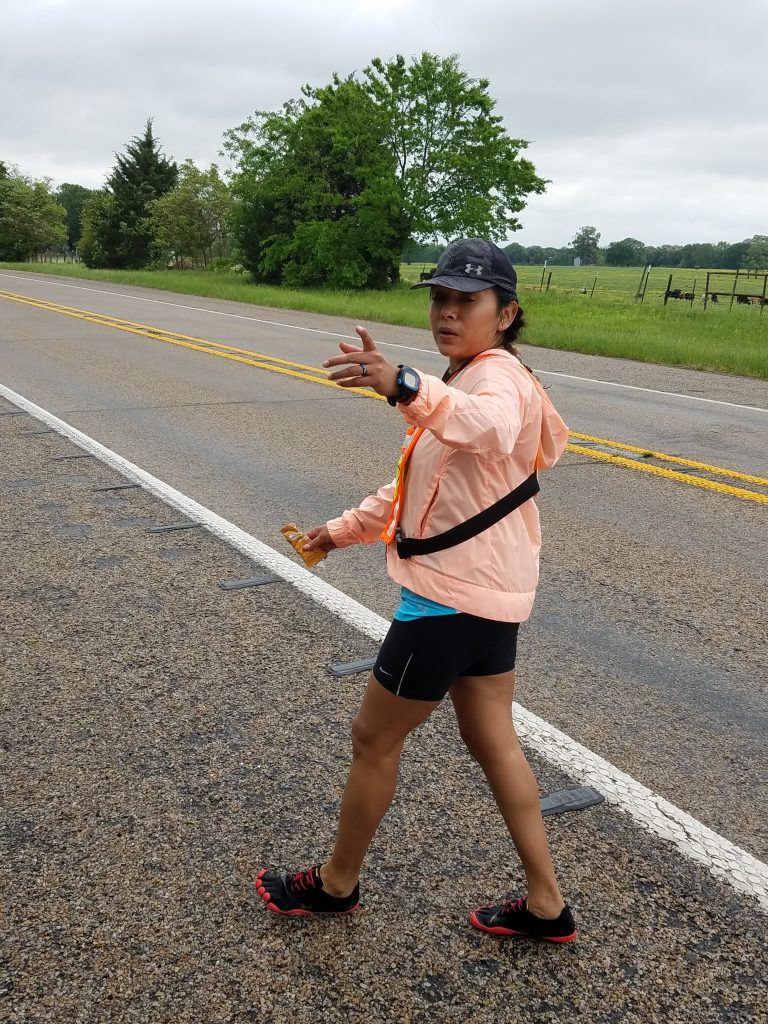
We stopped at the Brookshire’s for lunch, and just after returning from the restroom to the van, the rain came down hard. We ate in the back of the van and in about 20 minutes the rain was over.
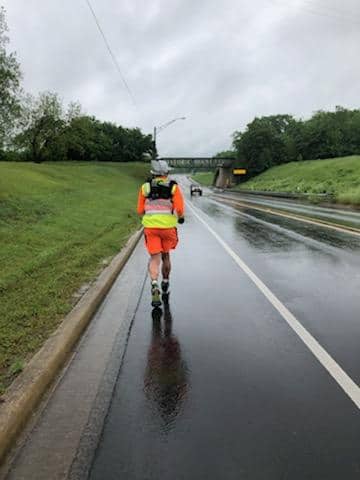
It was a treat to have someone run the entire day with me after the 4-day adventure with Eric way back at the start. And Angelica was a rock star. She ran competitive 100-milers and had a real ability to take miles under her feet without slowing down or getting crabby, as I had done. Running with Angelica gave me little bursts of speed that came out of nowhere! The miles would probably have gone by fast, but we had a lot of miles.
Angelica took photos of me at county and city signs, and somewhere along the route we encountered Jared Fetterolf, an elite ultra runner of Badwater fame. As usual, every person added to the company even for a few seconds really improved my spirits, made me forget about how my feet felt, and lowered my stress and blood sugar.
When we reached Mt. Pleasant, we were joined by Jeremy and Amber Hobbs daughter Jessica and son Jaxon, who ran 4 miles through town with us, to where 14th St. crosses Industrial. We made it to Sweet Shop USA with 10 minutes to spare before closing. The owner ushered us in and treated us to samples of some very nice chocolate.
After the Sweet Shop, the roads got a bit more hazardous and the Hobbs and Leslie and I agreed that it was a good place to part company.

We were making good time as we reached mile 38 for the day, and Angelica ran with me out of Mt. Pleasant along US-67 as far as Cookville, a total of 43 miles for the day. I ran the final mile by myself while Leslie portaged Angelica back to civilization and Mt. Pleasant, where she had arranged to have an Uber pick her up and return her to her home in Tyler.

US-67 had a narrow shoulder but was 4-laned, so a lot of traffic just changed lanes to avoid me. 6 miles before I decided to call it a day in Cookville, Angelica and I encountered a stray black pit bull – Labrador mix. No collar, running back and forth across the street. Cars were honking and we were afraid she would get hit. We managed to attract the dog to our side of the street and keep here there for a while, but we were sure she had escaped her owner across the highway. We led her over to where a man was standing, but he said that it wasn’t his dog and that she just kind of hung out there ever since her mate had been hit by a car.
“Cookie”, as I named her for the town she followed me to, was very affectionate, gentle, obedient, and intelligent. We had to leave her somewhere safe, so we chose the Dollar General next to a gas station that was being renovated. We figured the Dollar General was a good landmark to return to for the next day. I petted and hugged Cookie and told her she was a good girl, and gave her some water from one of my water bottles. We left her with some sliced beef we had in our fridge that was getting a bit old, plus some dehydrated chicken chunks that Leslie had been using to make soup.
When we returned to the Dollar General the next morning to resume our run into New Boston, Cookie was there waiting. We hated to leave her, but we don’t have room for a puppy in our lives right now. We hugged her, fed her, and Leslie distracted her while I ran off to the turn onto CR-3150.
If you see a stray black dog in Cookville TX, please adopt her. And give her some sliced beef or chicken. I promise you she will stay at your side until one of you dies. 🙁
Day 27 – Cookville to New Boston – April 19
38 miles.
It was a hard morning to start, and not just because of the miles. When Leslie and I returned to the Dollar General in Cookville where I had finished the previous day’s 44 mile run.
Cookie the dog was waiting, and when the van pulled up, she perked up and came walking toward us. There was sleepy in her eyes and I wondered if she had cried all night. She was as gentle and affectionate as she had been the day before, but it seemed now as if she were greeting a best friend.
It broke my heart to hug her, feed her and give her water, then run off as Leslie distracted her with more sliced beef and chicken. But we had no room for a puppy in our overfilled van, and still a fair distance to go.
The initial run on Cr-3150 was harder than I expected it to be. I suppose I was wearing down a bit. Maybe I was a little depressed from the exertion or from having to say goodbye to my new friend. Regardless, it was a quiet road, and as it reemerged near Omaha, TX, I felt purged and slightly upbeat, like I was starting to get closer to Texarkana for the first time. It was good Friday, and few places were open. We lucked out on a donut shop just east of the town’s very small downtown, bought an apple fritter and a kolache we didn’t eat, and used the restroom. US-67 held to its character as a shoulderless 4-lane road with spotty traffic, and I made decent progress, despite getting really tired of jumping out of the way of inattentive drivers I was sure would change to the unoccupied center lane.
Past Omaha was Naples, which had a sort-of grocery store and a gas station, both called Pruett’s. I got the impression somehow that most of the businesses in Naples were owned by this Pruett fellow.
The shoulders were narrow, there were a few bridges I had to sprint across due to the absence of any kind of shoulder, and there wasn’t much of a reason to stop, so aside from hydration and minor fuel breaks, we kept going. I don’t believe we even took a lunch break. In fact, I’m relatively certain of it, as it was a long day and I had a lot of miles to cover, and after we reached the turn onto TX-98 at Simms, there weren’t many opportunities to stop.
I ran past some beautiful fields of golden flowers and even some daffodils growing on the side of the highway, but somewhere in the middle of the piney woods, my feet *really* started to bother me. I could feel things in my socks, but when I took them off, there was nothing. Everything was sore, everything rubbed, and I was very hungry. At one point, I must have fallen back a bit, as Leslie texted me to ask if I was OK. I spotted her just over the next hill and we stopped for lunch some time around 2 PM.
Around the middle of the day, I encountered a guy driving along the shoulder toward me in a covered wagon. It felt oddly connecting to see someone moving at the same snail’s pace as me, and the sheer oddity of it all kind of woke me up and made me forget about how my feet felt for a while.
But I was flagging. At one point, I was moving so slowly, due to what felt like glass in my socks, that Leslie texted me to see if I was OK. She was just over the next hill, and I was glad to get a sit-down break, tend to my feet, and get something to eat. New Boston was still quite a few miles away, and I kept promising myself that if I couldn’t make it to New Boston, then I’d try to make it as far as I could and move the miles to the next day.
Little things would set me off or cheer me up. The pine cones along the shoulder were annoying. It felt like running an obstacle course, and yet, the blind hills and dappled shade made it hard to run in the cone-free road with any degree of safety. I felt incredibly grateful for the occasional guardrail and an opportunity to sit down for a few seconds and get off my feet.
Somewhere along TX-98 I met Ben. Ben was a complete stranger whose uncle and grandfather had been type 1. His uncle had passed away just 3 weeks ago from “dead in bed”, the unrecoverable low blood sugar episode that all type 1s fear and which nearly happened to me in Odessa.

Ben and I became instant friends. He was from Texarkana, and we shared our plans for the finish with him so he could follow the route.
I had to laugh as I passed the Telford Prison Unit on TX-98. There I was dressed in orange, wearing a RoadID ankle bracelet, running past a prison.
The road was busy, but the grass was mowed across from the prison, so the going wasn’t bad. The grass was soft and the dirt was easy on my ankles, and I made decent progress.
I reached the turnoff to CR-1840, just past a church, in reasonable time, but the handful of miles along CR-1840 to CR-8 seemed to last forever.
Once I turned onto CR-8 to run the remaining 1.5 miles to the day’s-end point at the Shell station across from the Holiday Inn at CR-8 and I-30, my feet really hurt and I kind of “stumped” it to the bridge crossing over US-82, tottered along the grassy berm next to the unusually busy half mile of road, and checked into the hotel.
That night we put diclofenac on my ankle and instep, put new blister dressings on the ends of my toes, and retaped my feet for the 23 remaining miles.
Day 28 (fractional day) – New Boston to Texarkana – April 20
23 miles. The first 13 miles or so were straight along US-82, along a narrow shoulder but relatively free of traffic, as it was a Saturday. I’m not sure exactly where it was, but it was somewhere near a church where I had sat down to fish for invisible debris in my shoe again. I heard a runner approach from behind, shouting “on your left!”
It turns out my brother Walter Muchow had driven with his wife Lila from Fayetteville, completely in secret, to surprise me near the finish. I may have let some expletives fly, but I was beyond overjoyed to run into Walt and Lila.
We had a brief lunch at the back of the van. Walt ran about 4 miles with me and then rejoined Lila to drive into Texarkana so they could run the last mile.
Leary, Victory City, and Nash kind of came and went. Leslie met me at a school parking lot along the way and we had a hot meal. We were ahead of schedule. Our plan had been to arrive around 4 PM in time to talk to a reporter from the Texarkana Gazette. 5 miles out, It looked like I might arrive early, and Leslie called the reporter, who scrambled to meet us and got a story a little after the finish.
Ben met me at the turn onto Texas Blvd, and Walt and Lila met me near the hospital on Texas Blvd. All 3 ran with me to the finish.
I arrived at my destination, Texarkana Texas City Hall, on Saturday April 20th at 3:36 PM. I stopped my GPS watch and InReach tracker once my brother arrived at the finish. I was done. I had made it. My feet hurt, but I was not dead. I was in a good mood, and just for fun, ran across the state line into Arkansas. Leslie and I joined Walt and Lila for dinner, and I ate voraciously, for the first time, in no hurry to be anywhere.
I’ve learned a fair bit from this run and those that came before it: not just about balancing food and insulin with exercise, but about insulin sensitivity, stress, and the 20+ factors that affect blood sugar at any given moment, only two of which are food and insulin. I’ve learned to listen to my body. I’ve learned about the value of persistence, determination, and thoughtful, methodical planning. The learning hasn’t always been easy, and in some cases, I’ve had few examples to learn from with regard to type 1 diabetes and multi-hundred mile runs.
Looking back, I am tempted to say it was the hardest thing I have ever done. And in some sense, that’s true. Up until that point, I had never run across Texas before. I had never run 850 miles as a single undertaking. But Capital to Coast had been harder in some ways due to the sleep deprivation. The run across Iowa had done a better job of grinding me into dust with its thunderstorms and 50+ mile days. My feet had blistered far worse on my first 100-miler. And to be honest, in some ways, the hardest thing to do during those 27 days and change was to get up after my forced rest day in Odessa and keep going.
To me, it’s a harder thing to keep getting up when something like type 1 diabetes indiscriminately knocks you down; to keep going and keep trying when nothing seems to work the same way twice in a row. To my diabetic brothers and sisters out there in the #t1dtribe, you are all heroes and #diabadasses.
Just waking up in the morning is a victory. What you do after that is up to you.


